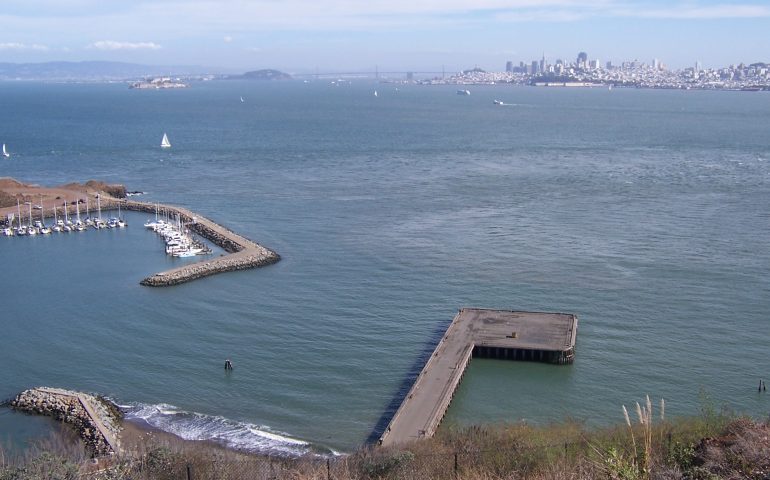Public Pier — No Fishing License Required
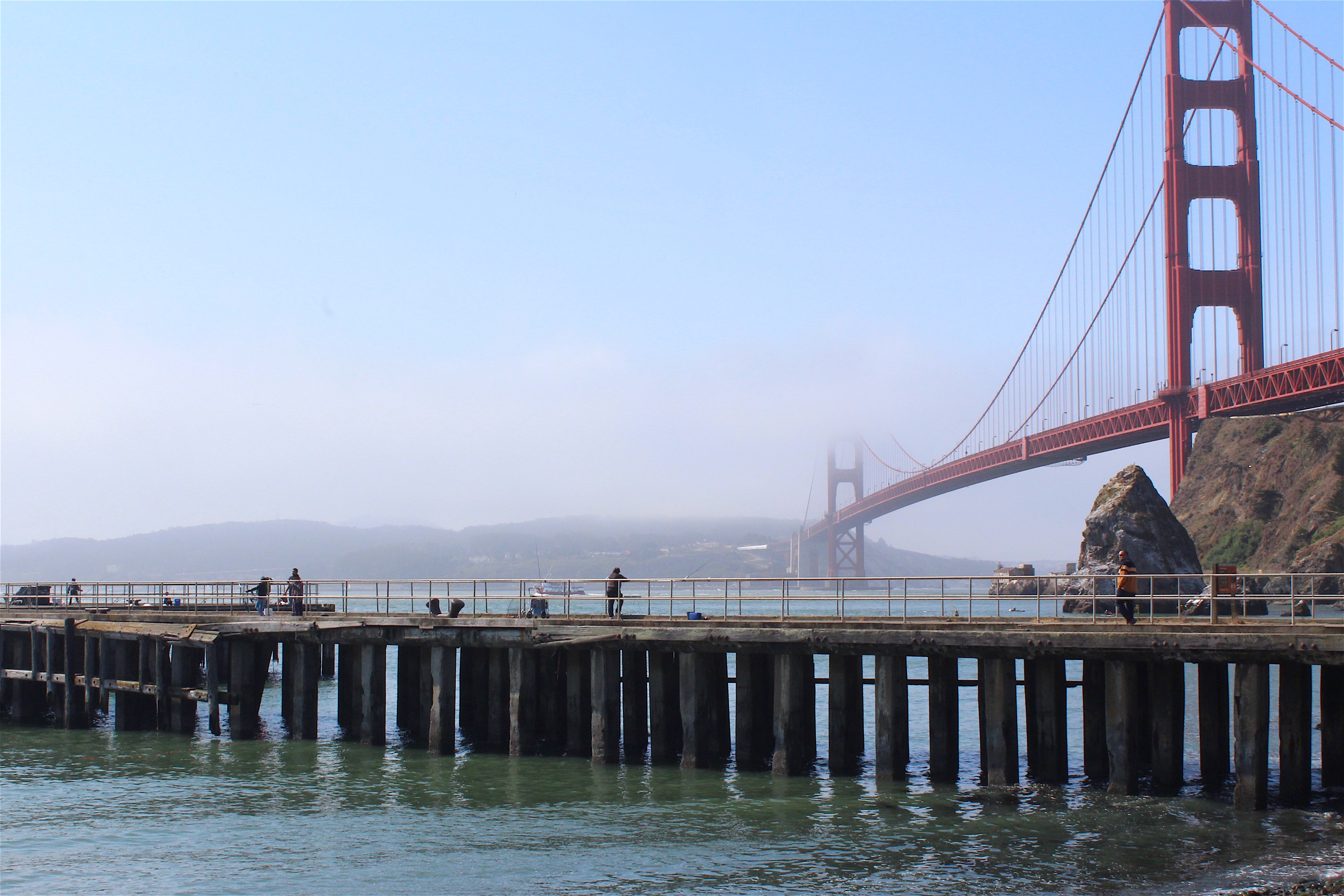
Like its counterpart across the bay, the Fort Point Pier, this pier offers not only decent fishing but one of the world’s most interesting and beautiful views. Look up to your right and you are looking into the Golden Gate Bridge, one of the world’s greatest engineering feats when constructed in the ‘30s. Look across the bay and you see San Francisco, “The City” to locals, and a magical destination for many.
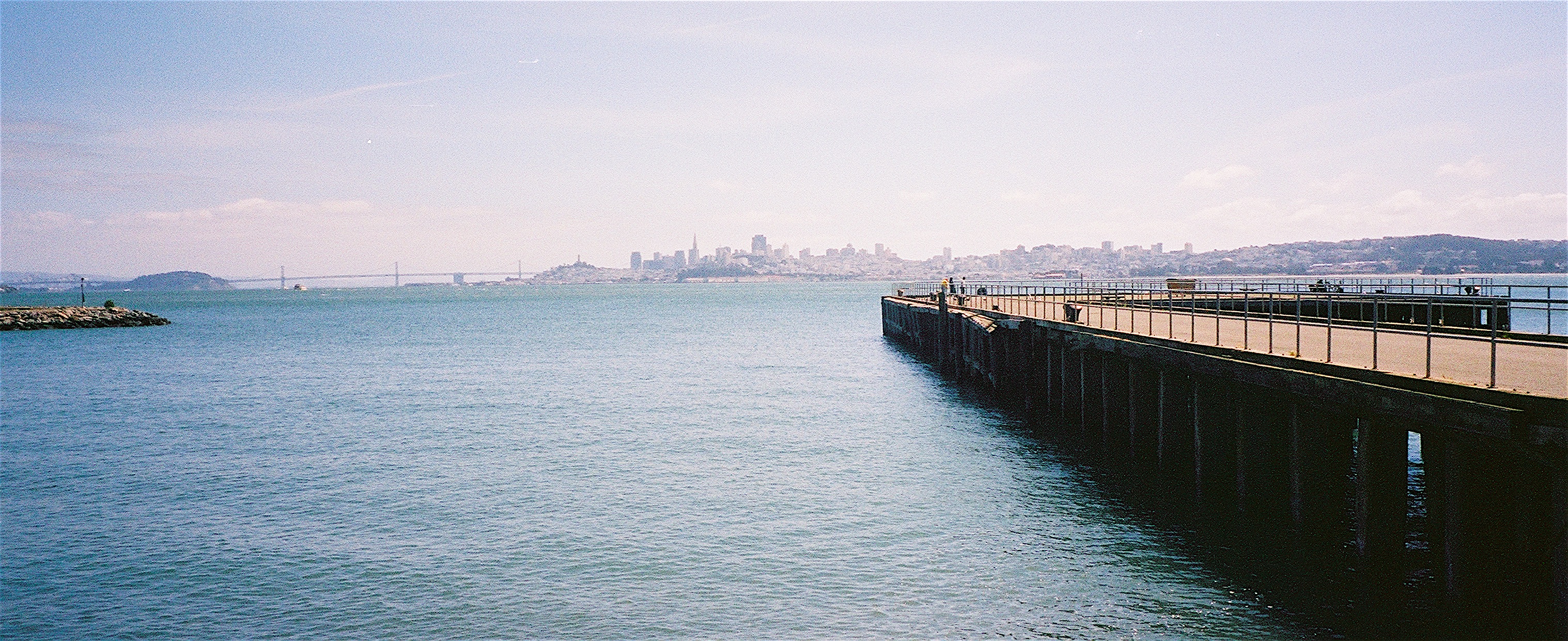
The Pier and “The City” across San Francisco Bay
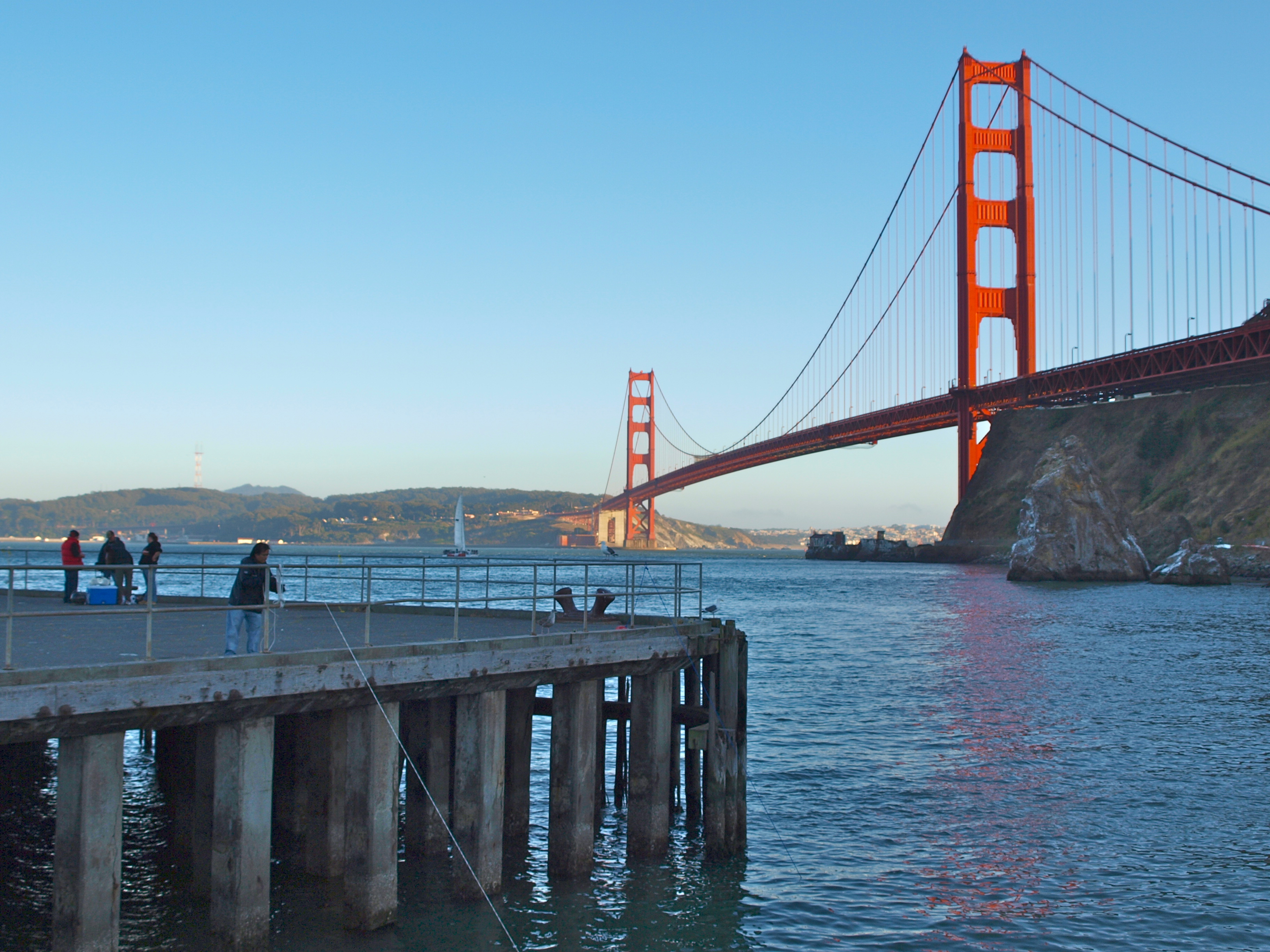
The Golden Gate
Look at the bay and you will see Angel Island, Alcatraz, and an unending number of boats, everything from the smallest sailboats to large luxury liners and even larger oil tankers.
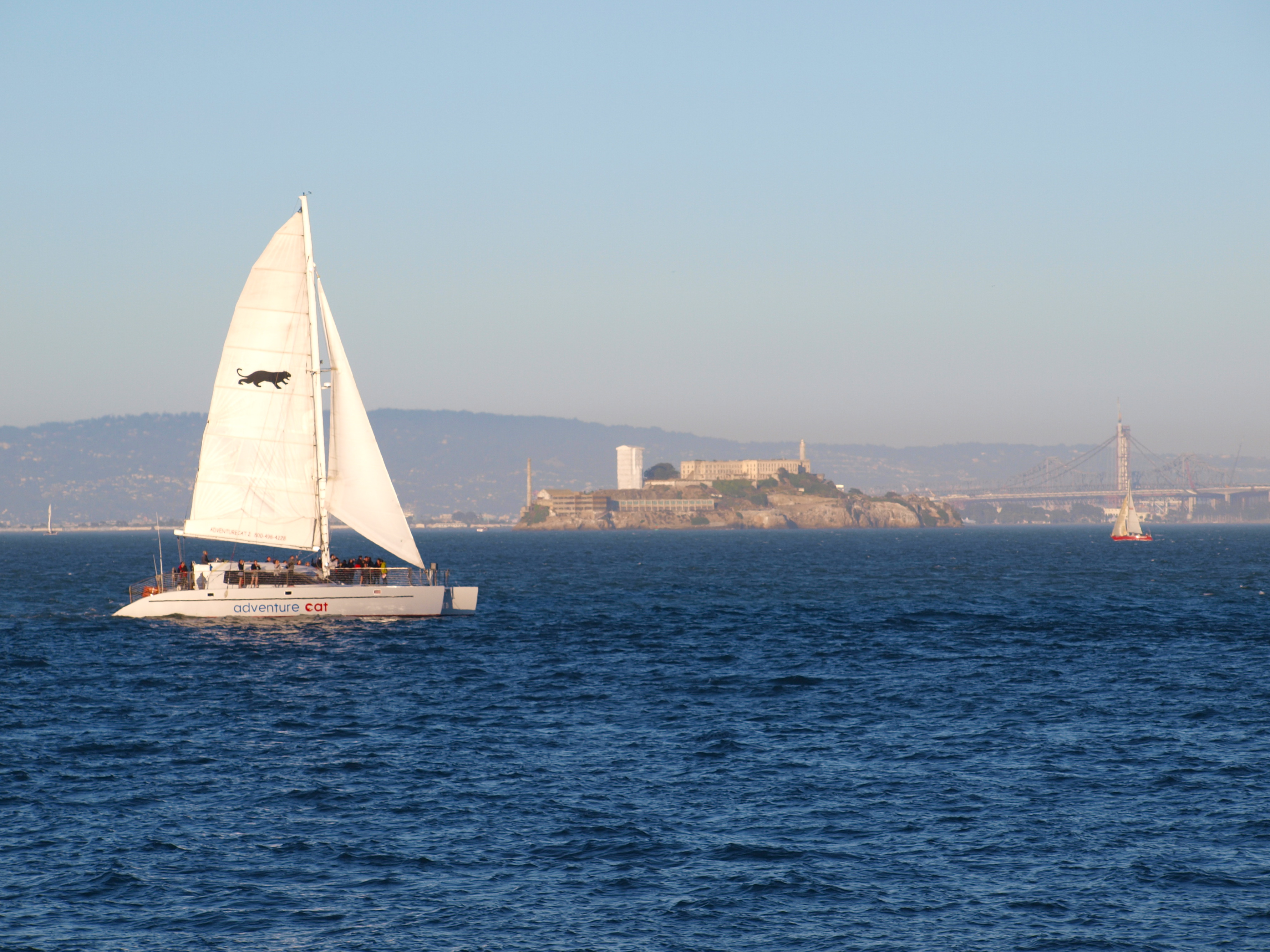
Alcatraz Island and sailboats
Consider the waters of the bay itself and imagine the energy that is channeled through the mile-wide width and two-hundred-feet depth of the Golden Gate. The result is a powerful stream that is buffeted and shaped by the contrasting forces of nature—river flow rushing down to the sea from inland California streams, tidal waters that push in and then pull out on a twice daily basis, and powerful winds that roar in off the Pacific. The resulting waves, eddies, and whirlpools can surprise even the most experienced mariner. Imagine what life is like for the fish that live in that environment. It is hard to fish from this pier and not recognize that San Francisco Bay is one of the world’s greatest bays.
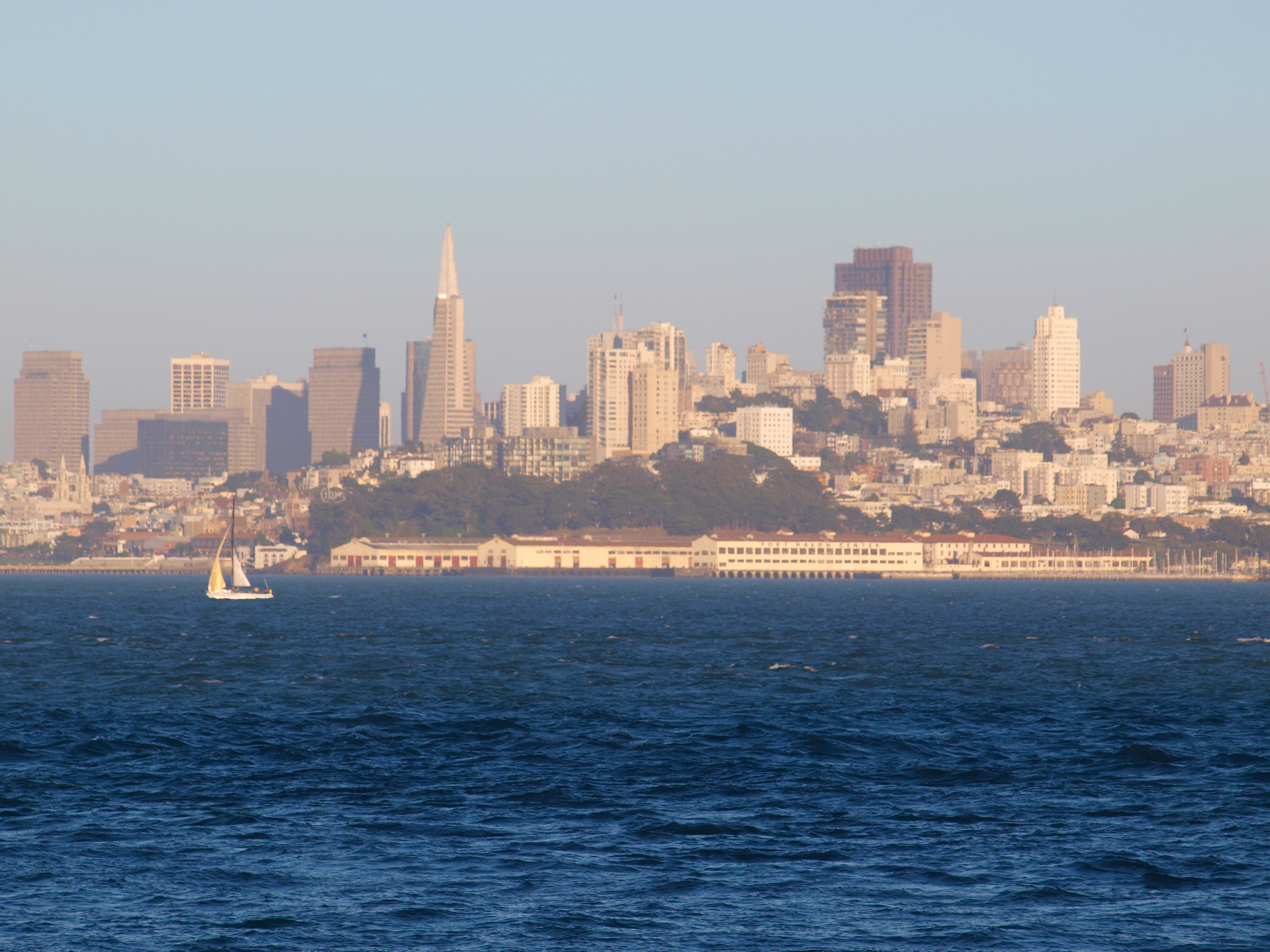
“The City” and the piers at Fort Mason sit across the water
Of course there are many days when you can see little but fog as it moves in through the Golden Gate. Carl Sandburg, one of my favorite poets, wrote the following —
The fog comes on little cat feet.
It sits looking over harbour and city
on silent haunches and then moves on.
The poem doesn’t seem to match what’s seen here. Here the fog comes crashing in with ocean’s fury, rushes through the Golden Gate, and envelops the bridge, the bay and “The City” across the bay. It can pound the senses, make a summer day feel like an Arctic night, and pierce even the heaviest coats. At times it can seem to lend an almost surreal feeling to the entire area. But then it can lift, the sun appears, and a magnificent scene surrounds the angler. The always changing scenes and pictures are one of the attractions of the pier.
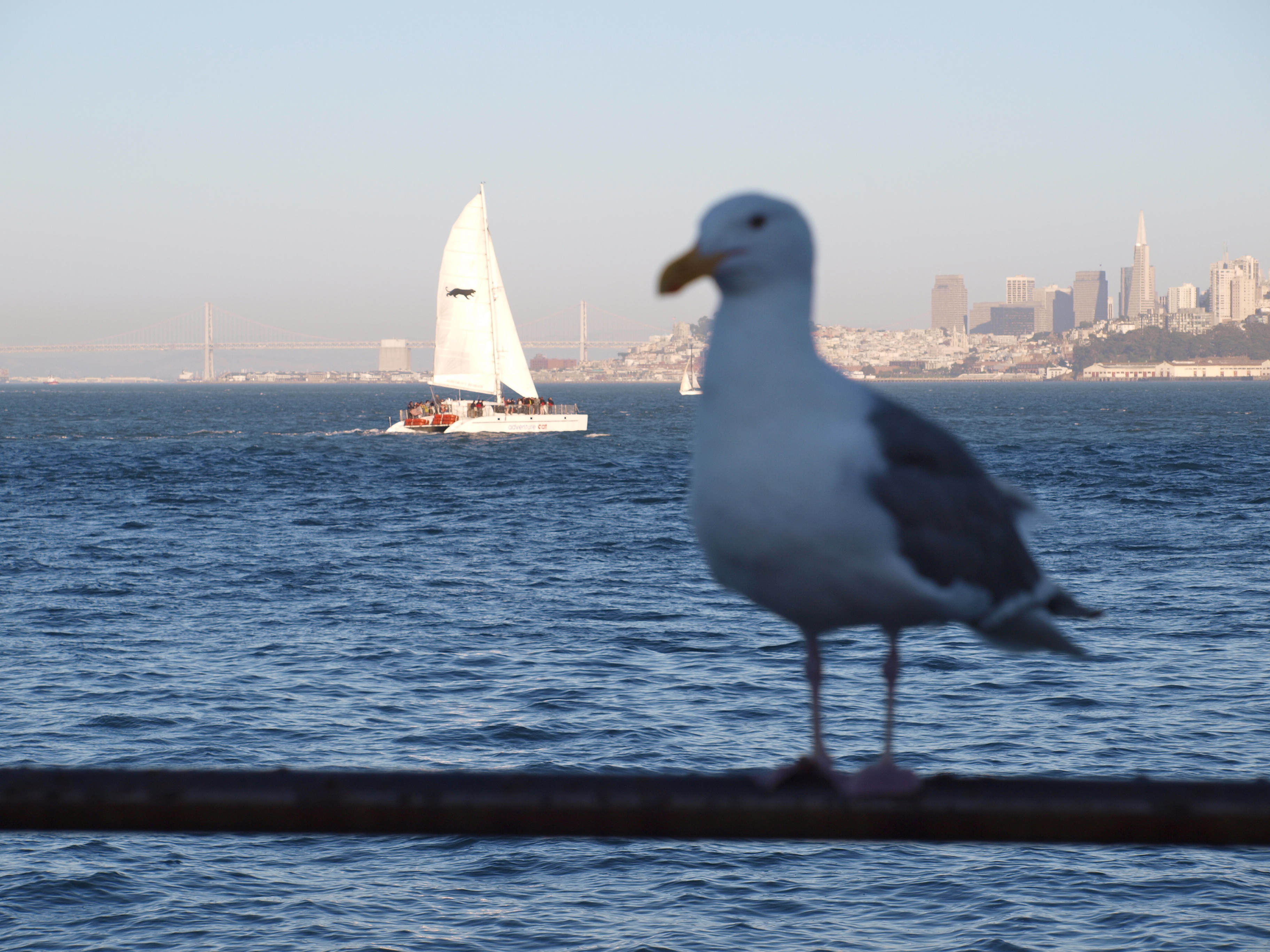
Sea Gulls are constant companions
Environment. This area is part of the Golden Gate National Recreation Area, a park of more than 38,000 acres that sits on both sides of the Golden Gate Bridge. The pier sits at the western corner of Horseshoe Bay/Horseshoe Cove, a Coast Guard station (of types) is located just a short distance from the pier, and across the bay/cove sits the Presido Yacht Club that is protected by the Satterlee Breakwater, an excellent fish-rich jetty used by shore anglers.
The pier itself is a former military wharf built at the south end of Horseshoe Cove/Bay which gives reason for a couple of alternate names, its original name the East Fort Baker Mine Wharf, and the Horseshoe Bay Pier. It’s also at times been called the Moore Road Pier. Although the current pier dates to 1937, wharves of various size and purpose have been located on the same site since the 1870s.
At times the pier was dilapidated and in danger of being torn down. Today, it has been renovated and seems in good shape although it’s a little smaller than the original wharf. Up until the mid ‘80s there was a L-shaped main section to the pier and a smaller concrete pier on the west side; together they created a U-shaped pier. The concrete pier is gone but the surface has been improved and railings added which makes it a safer pier for children. This is good news because the pier at times offers better than average angling.
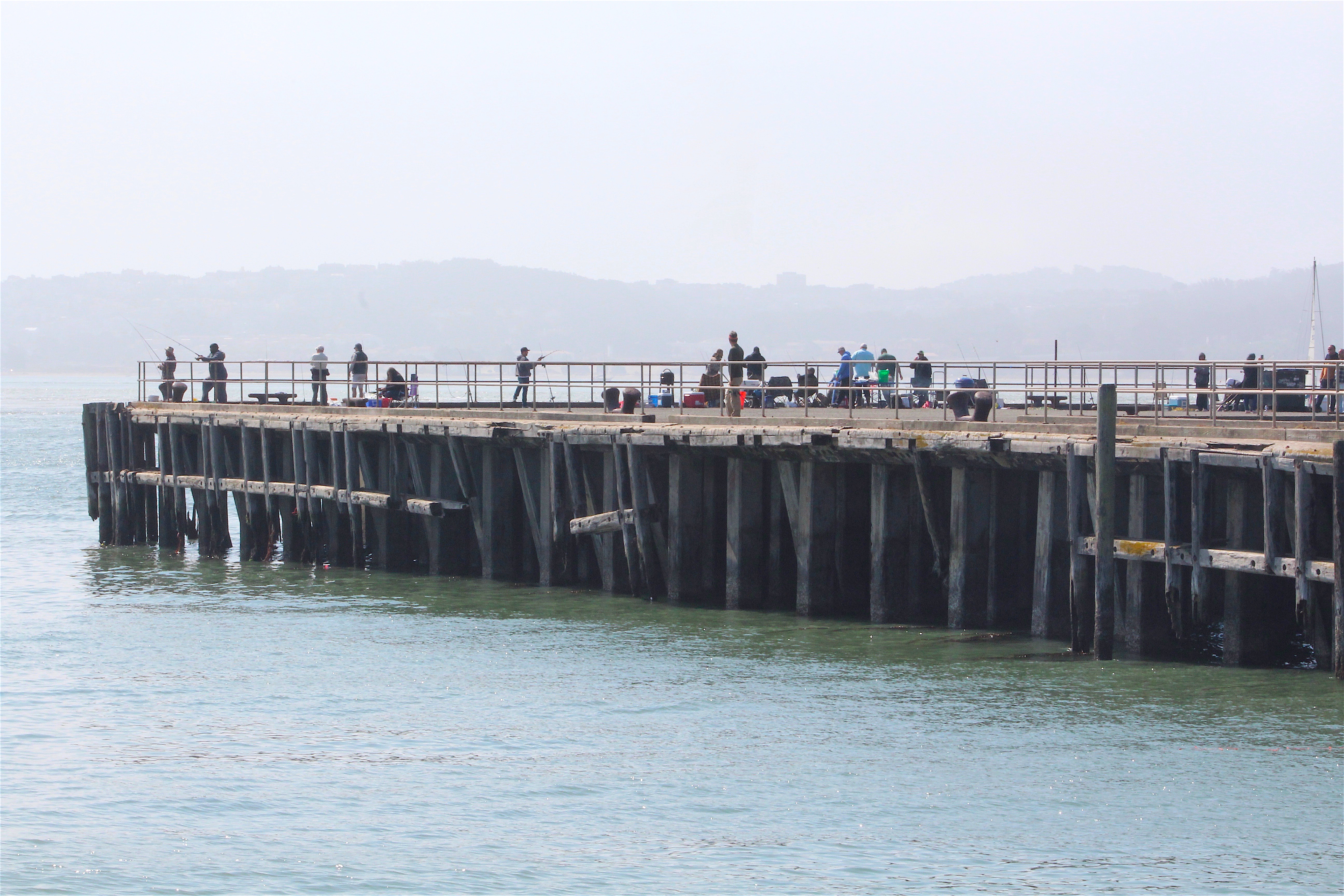
Most of the bottom around the pier is sand and mud, although the inshore section offers a rocky shoreline on the west side and a pebble beach on the east side.
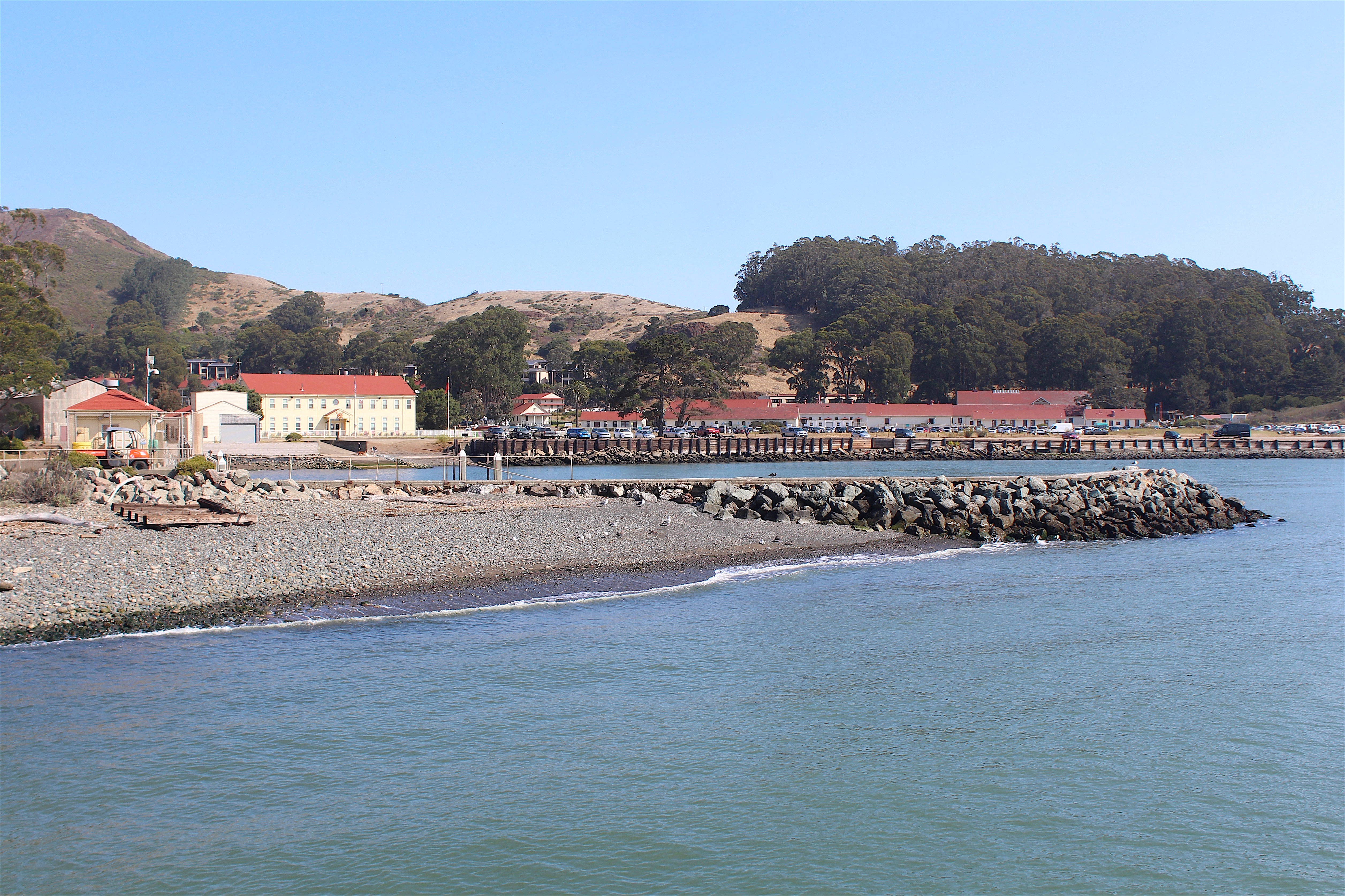
The pebble beach to the left (east) side of the pier
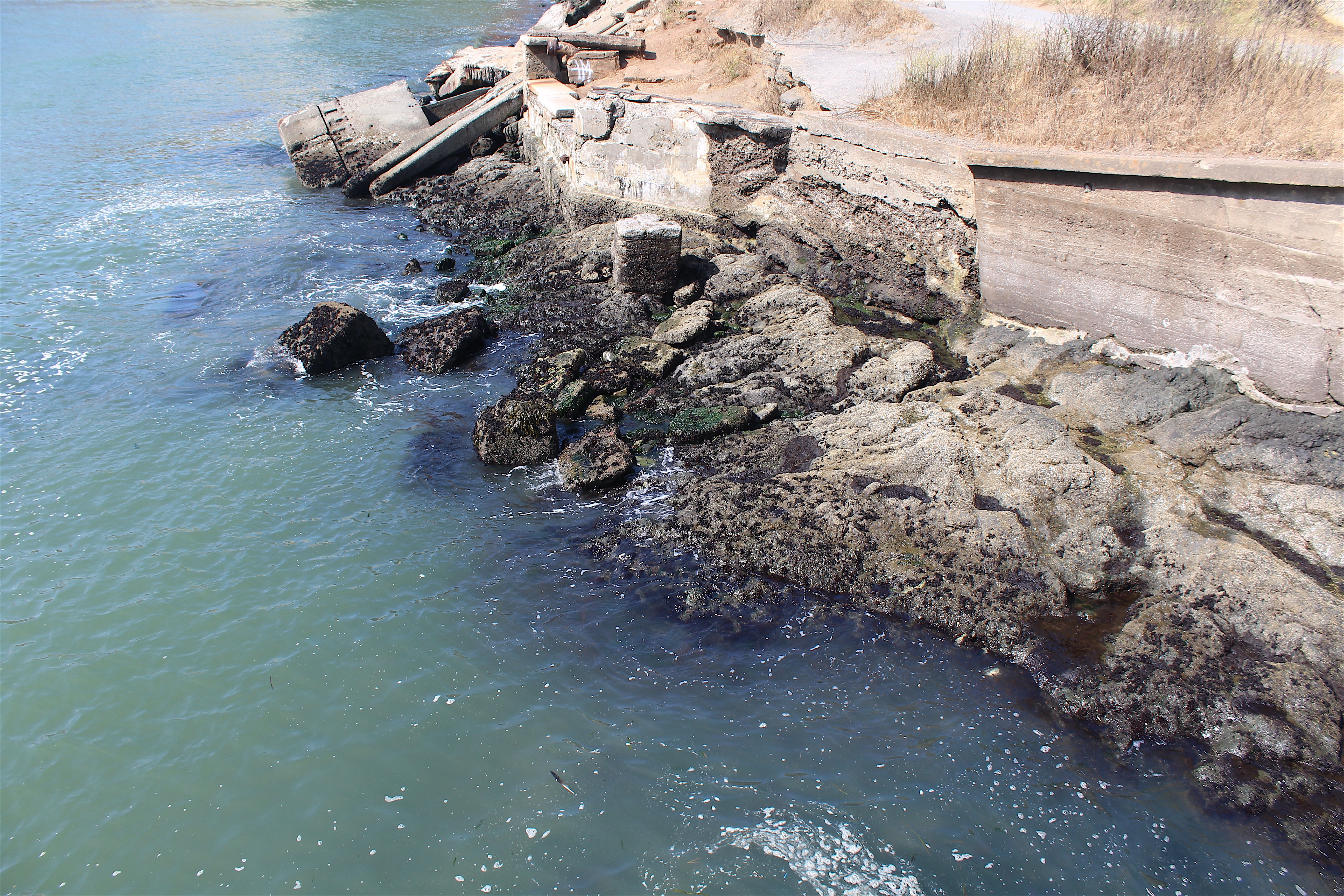
Shoreline rocks to the right (west) side of the pier
Jacksmelt are one of the mainstay fish at the pier and casting out from the end, away from the pier, is generally the best spot for the large silversides (they’re not true smelt). Strong currents sweep in and out through the Gate, pass by the rocky Point Cavallo, and head down shore to Sausalito. Jacksmelt seem to follow the currents around the point and past the pier and on good days lucky anglers will fill buckets with the large and tasty smelt.
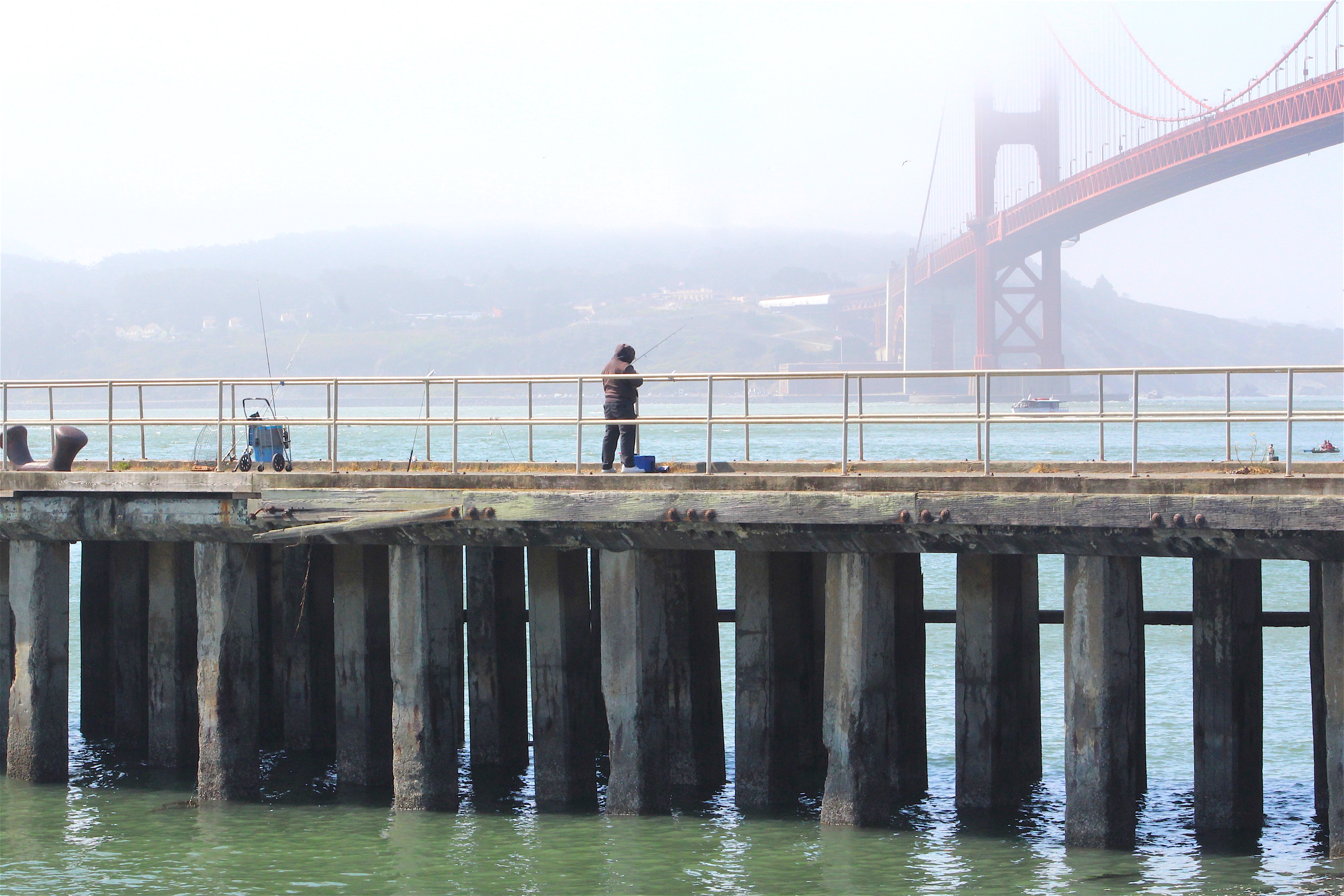
The end section and its deeper water is also the main area where the “sharkers” seek out the large sharays in the bay — the sharks and rays (mainly bat rays) that call the bay their home.
Although large leopard sharks and soupfin sharks are somewhat common, large bat rays aka mud marlin are usually the main and largest catch. Many of the old mama bat rays (all big ones are females) will be caught in the 50-75 pound range and some may even approach or exceed 100 pounds in weight. The fight of these large mud marlin can be exciting and exhausting.
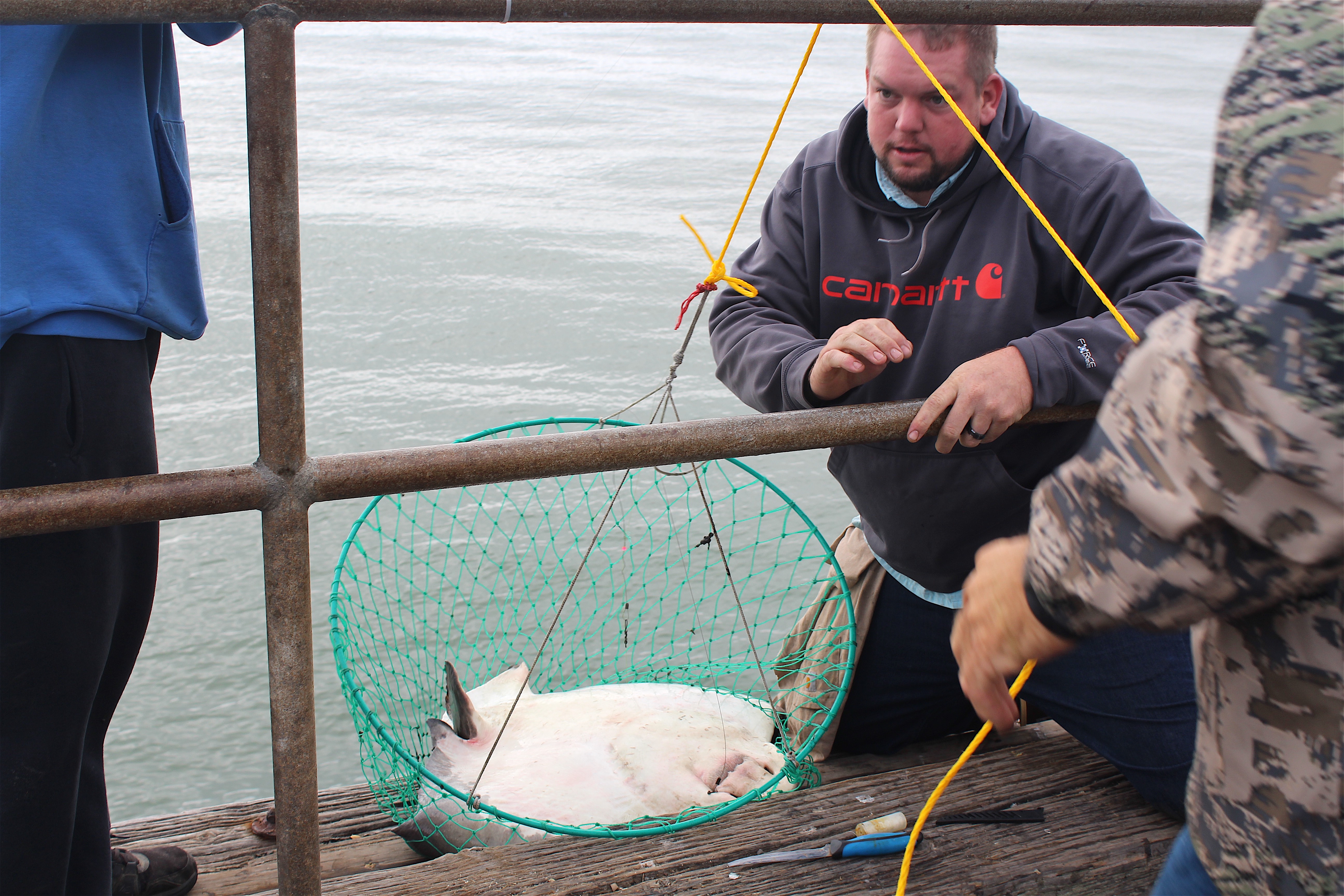
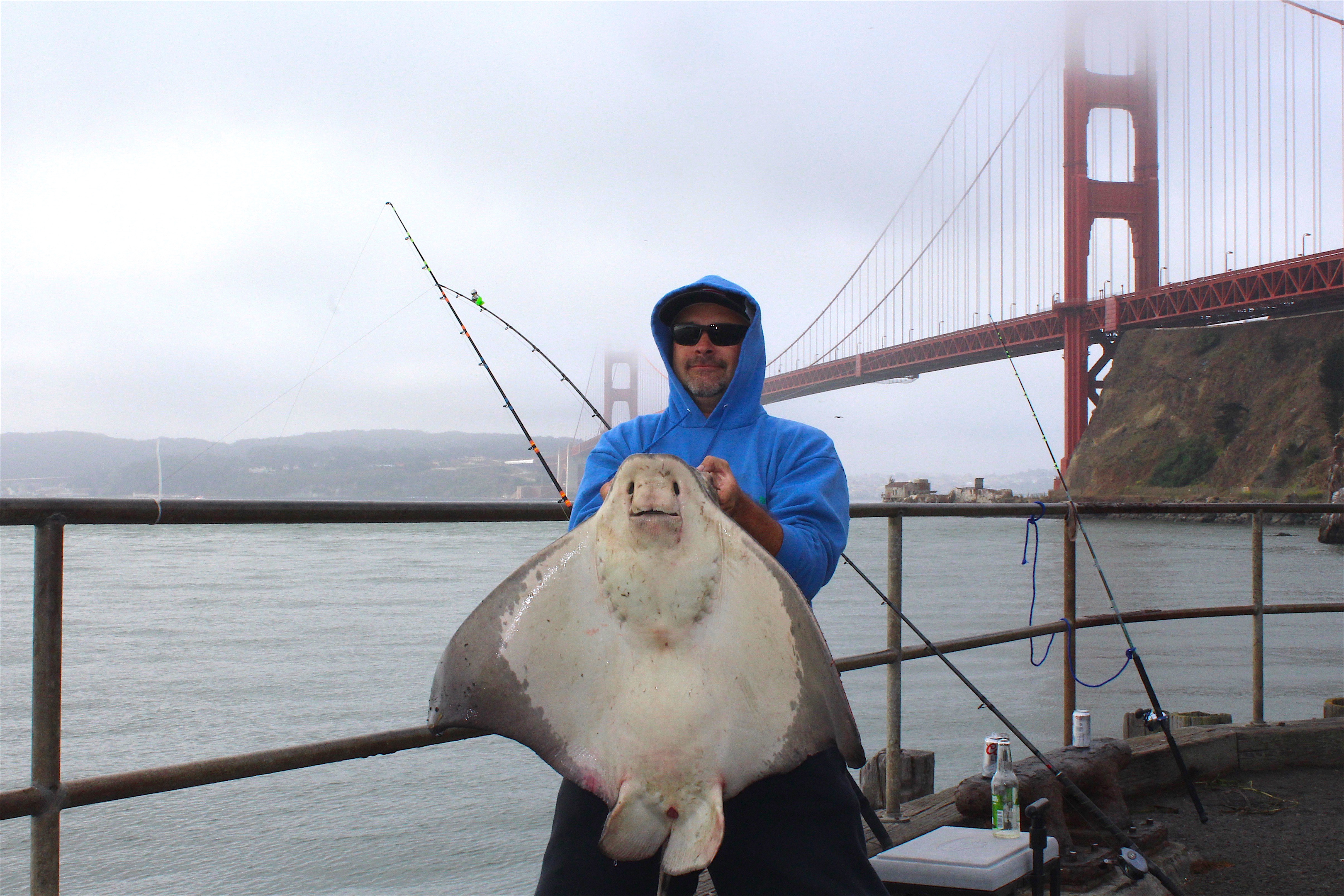
The end section is also preferred when the sanddab show up and when present the end section of will be filled with anglers seeking out the small flatfish.
Under the wide section of the pier are hundreds of concrete pilings and most are covered with barnacles and other growth. Here, under the pier, and towards the old concrete pilings is the area to fish for a wide variety of perch, small rockfish and an occasional cabezon or lingcod.
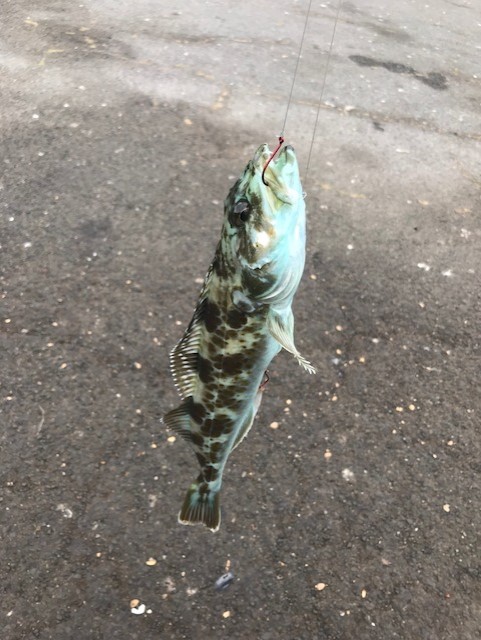
Lingcod caught by Matt Shockley
Inshore, about one third of the way out on the west side of the pier is a primo spot for perch. Regulars say it’s the best spot for the larger rubberlip perch and blackperch.
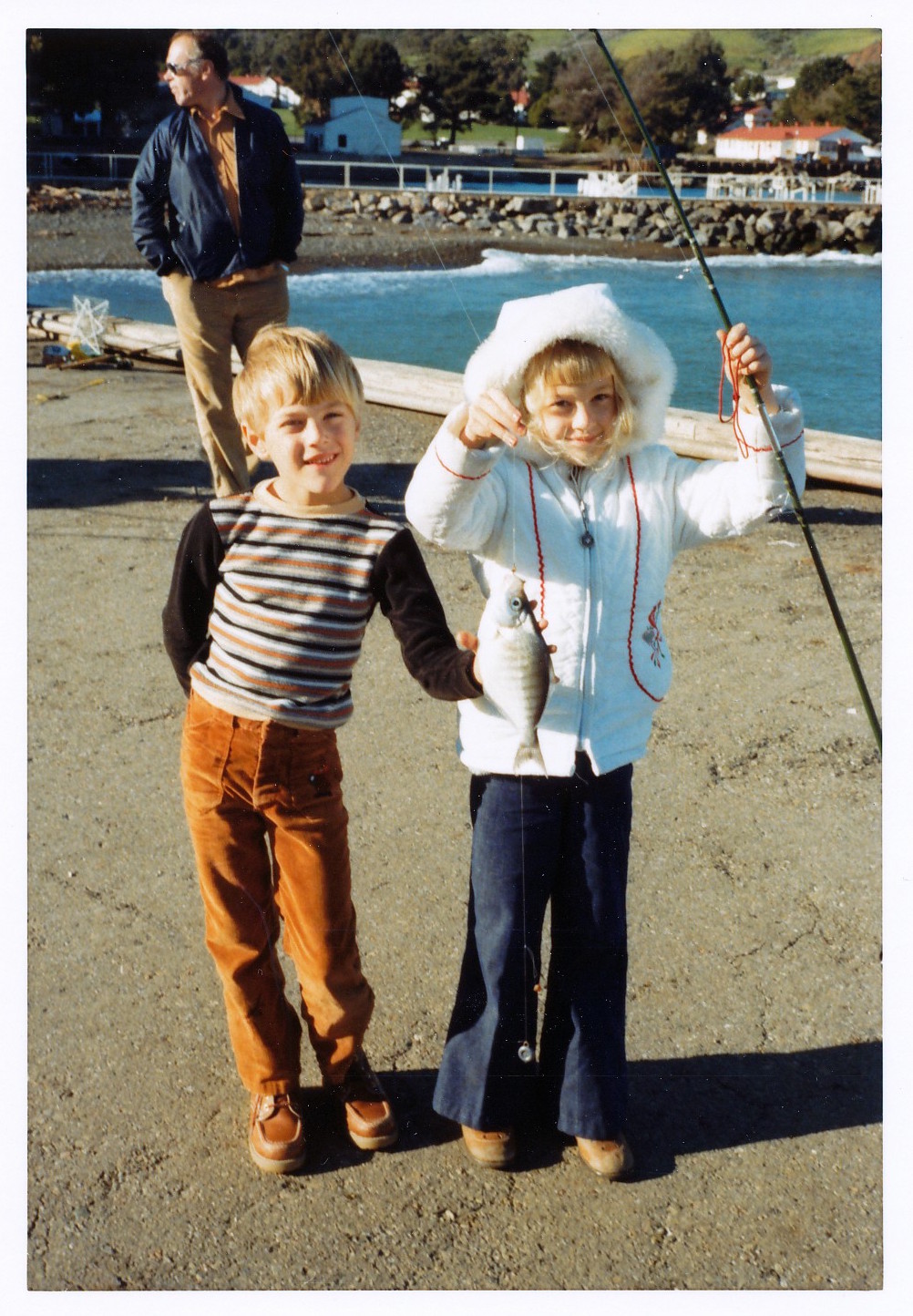
My son Mike and daughter Kim with a walleye surfperch in 1978
Fishing Tips. For most species of perch, fish straight down or underneath the pier. Use a light line, size 4 to 8 hooks, and most important, use small pieces of pile worms, shrimp, or fresh mussels for bait. If you want, overturn some inshore rocks and grab some of the small green rock crabs, they also make good perch bait.
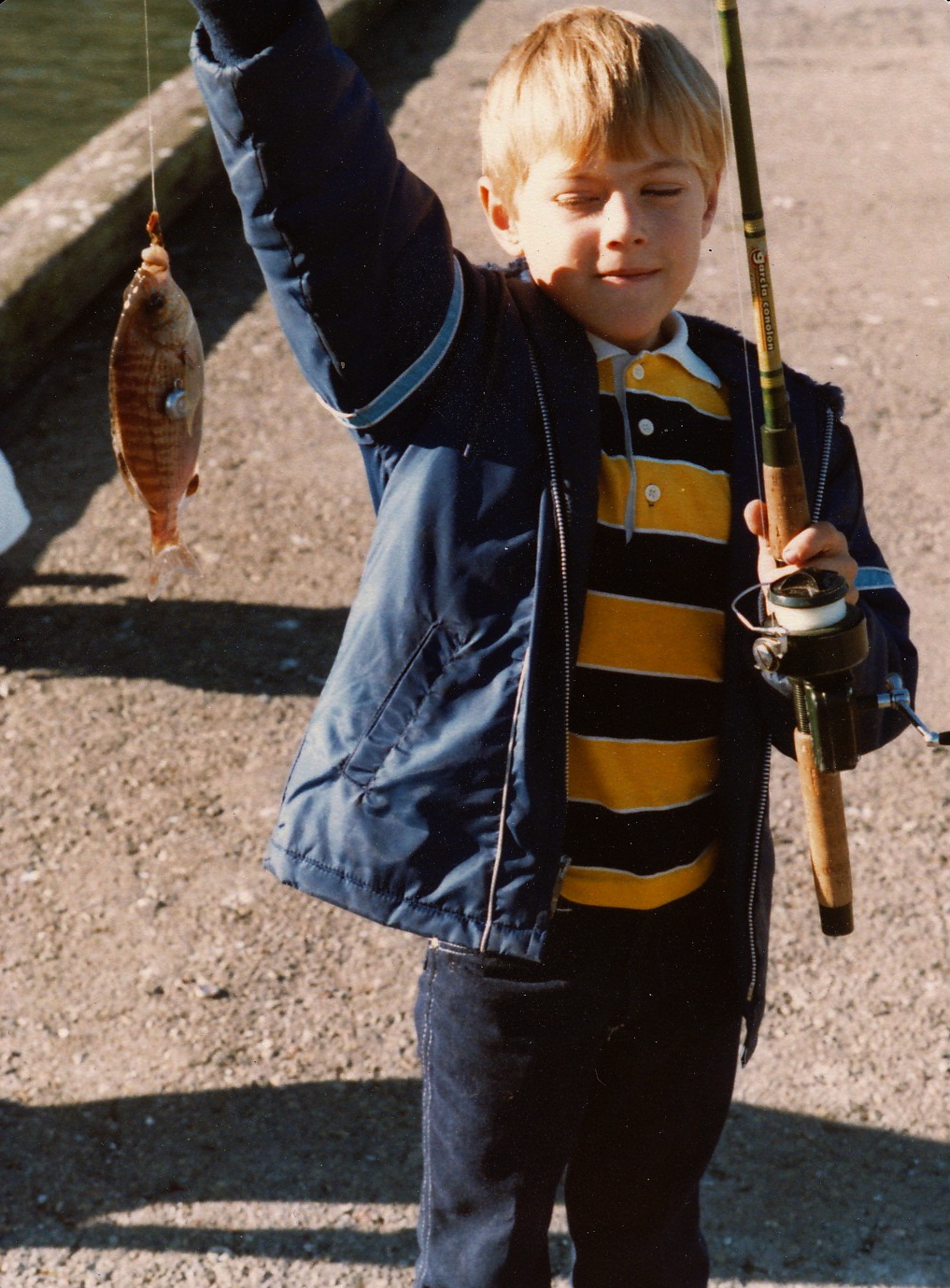
My son Michael with a rainbow seaperch
During the winter and early spring you may catch pileperch, rubberlip seaperch, striped seaperch, rainbow seaperch, and an occasional redtail or calico surfperch. Almost any time of the year may yield blackperch (called pogies by locals).
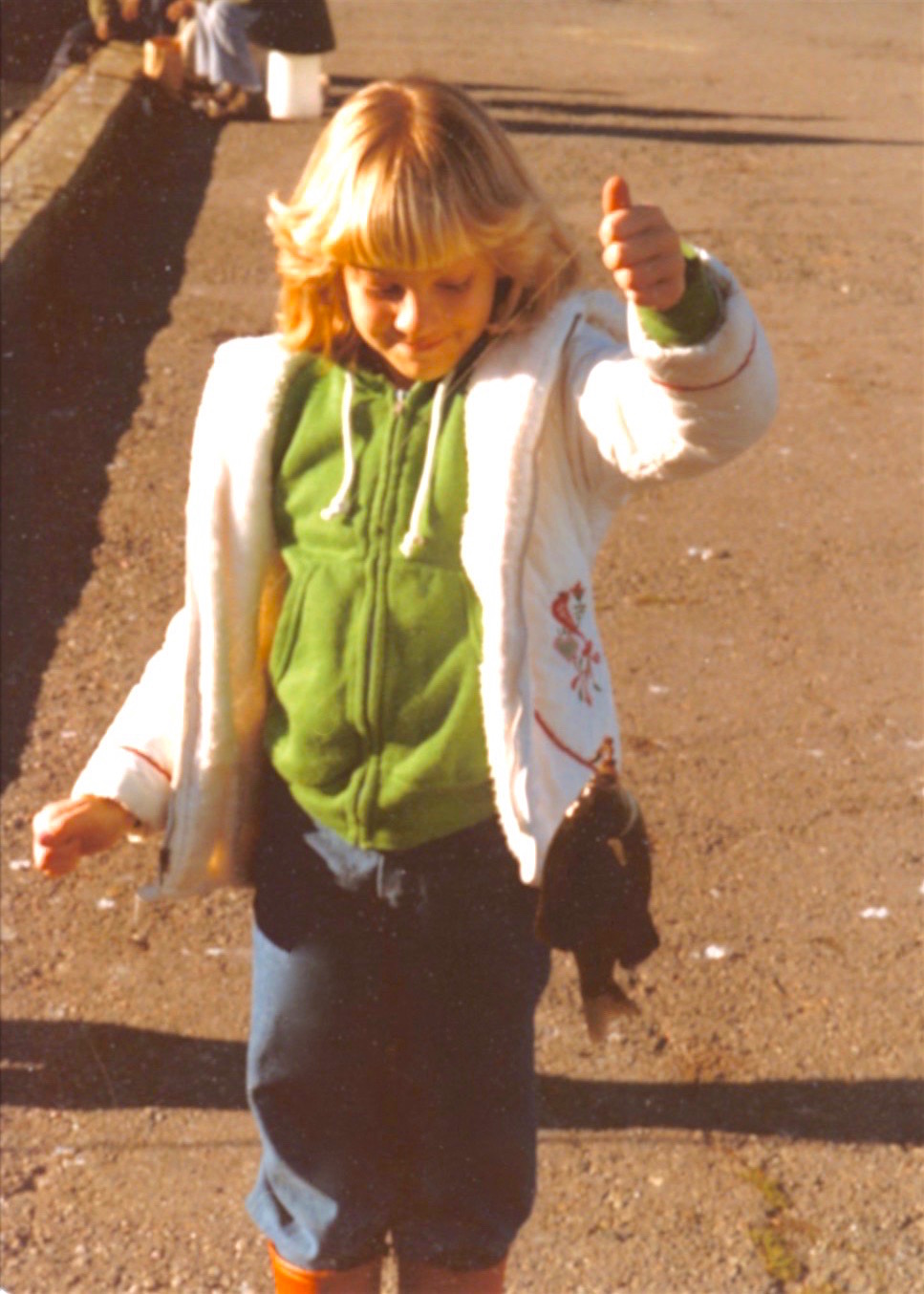
My daughter Kim and a blackperch — 40 years ago
For all of these perch species, use a high-low set-up and fish on the bottom around the pilings. If bait isn’t producing any bites try lures—plastic grubs or small spoons—and simply jig them up and down in the water near the bottom. Root beer or oil-colored grubs can be deadly as can small 1/12 or 1/8 oz. chrome, chrome with blue, or chrome with green Kastmaster spoons.
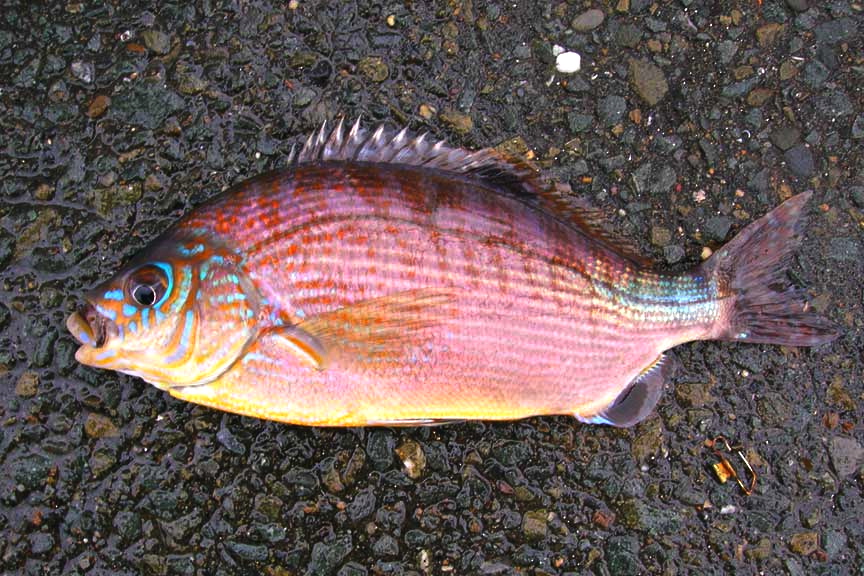
Rainbow Seaperch
Later in the year, spring to fall, seems to be the best time for walleye surfperch and silver surfperch (although the perch closure in the bay means no perch excepting shinerperch from April 1 to the end of July). For these smaller perch, use a small piece of anchovy and fish mid-depth, or let your line sink to the bottom then slowly retrieve the line all the way to the top. Almost any time of the year can also yield white seaperch but these seem to hit best with a short cast away from the pier on the left (east) side of the pier.
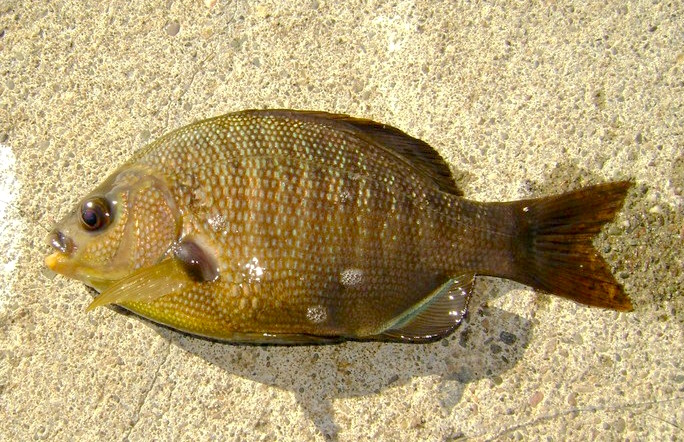
Black Seaperch
The same bait and riggings will also yield a lot of undersized bottomfish when fishing under the pier; this is hard to avoid but does yield some interesting variety. Included in my catch have been cabezon, kelp greenling, black, blue, gopher and brown rockfish, smoothhead sculpin, scalyhead sculpin, onespot fringehead, and blackeye goby. Occasionally a larger than expected lingcod will grab an angler’s line which of course can also attract a larger than expected mob of onlookers.
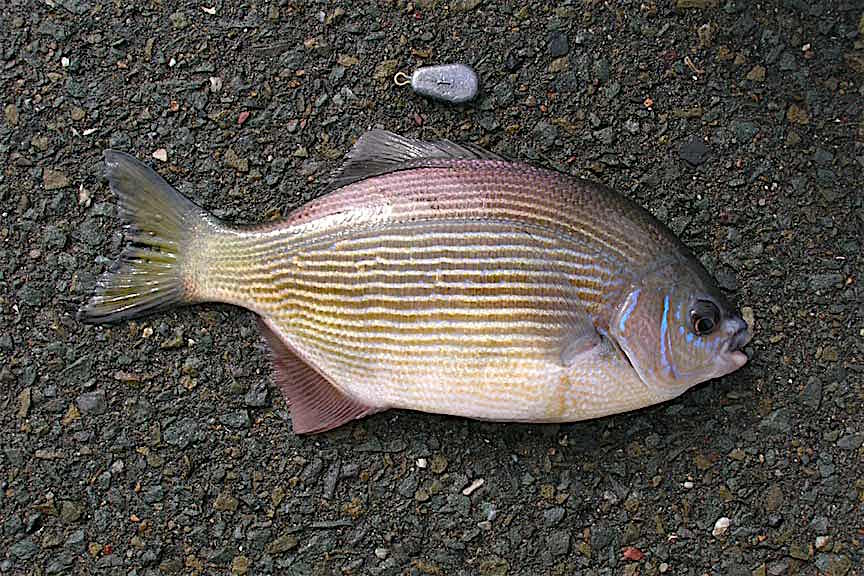
Striped Seaperch
Fishing close in to the shore, in fact right up by the rocks, will sometimes yield a blackperch or a rubberlip perch and can surprise you with a monkeyface eel. However, do watch your line closely because the fish will typically hit and head straight under a rock. It’s easy to lose gear, even when it’s nothing but a baby cabezon, kelpfish, or other interesting rock-infesting creature.
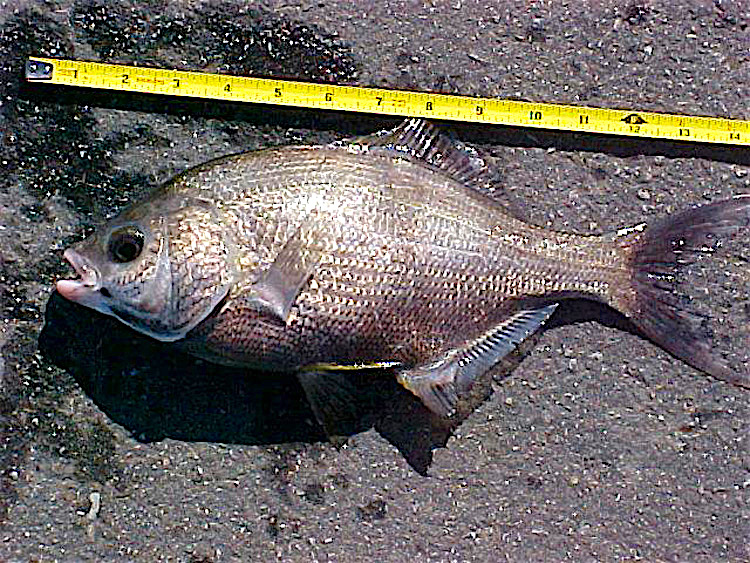
Pileperch
Casting straight out from the pier or to the right is less productive but does yield some fish; most common are jacksmelt but sometimes you’ll also encounter kingfish (white croaker), true tom cod (in the summer), small rockfish (primarily brown or grass rockfish), and a variety of flatfish — starry flounder, Pacific and speckled sanddab, sand sole and English sole. For most of these, a small strip of anchovy seems to work best, although the starry flounders also like grass shrimp. Rigging typically is a simple high/low or the plastic fish finder rigs. Do keep the hooks reasonably small, i.e., size 4.
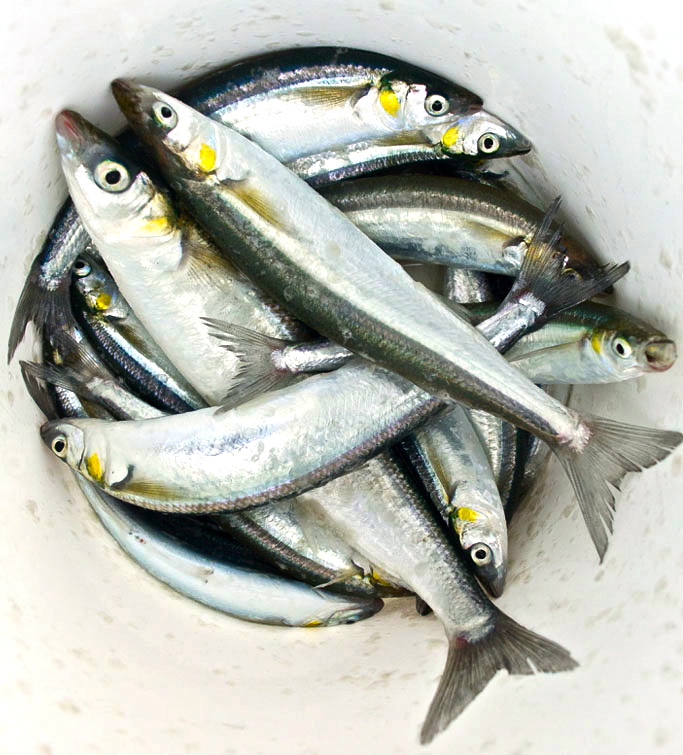
Jacksmelt
Some years (usually wet-water years) will see huge schools of sanddab invade the local waters during the winter months (December-January); when they do, anglers may catch a fish on every hook, on every cast. Families will flock to the pier and five gallon buckets will be overflowing with the small, but tasty, flatfish. The typical rigging simply has two or three small hooks (size 6 or 4) on dropper leaders above the sinker. Best bait is often pile worms but pieces of market shrimp, cut anchovy, and even strips of squid will usually work. Squid by the way may be the best protection against the crabs but when the sanddab are present you can expect bites almost as soon as the bait is on the bottom.
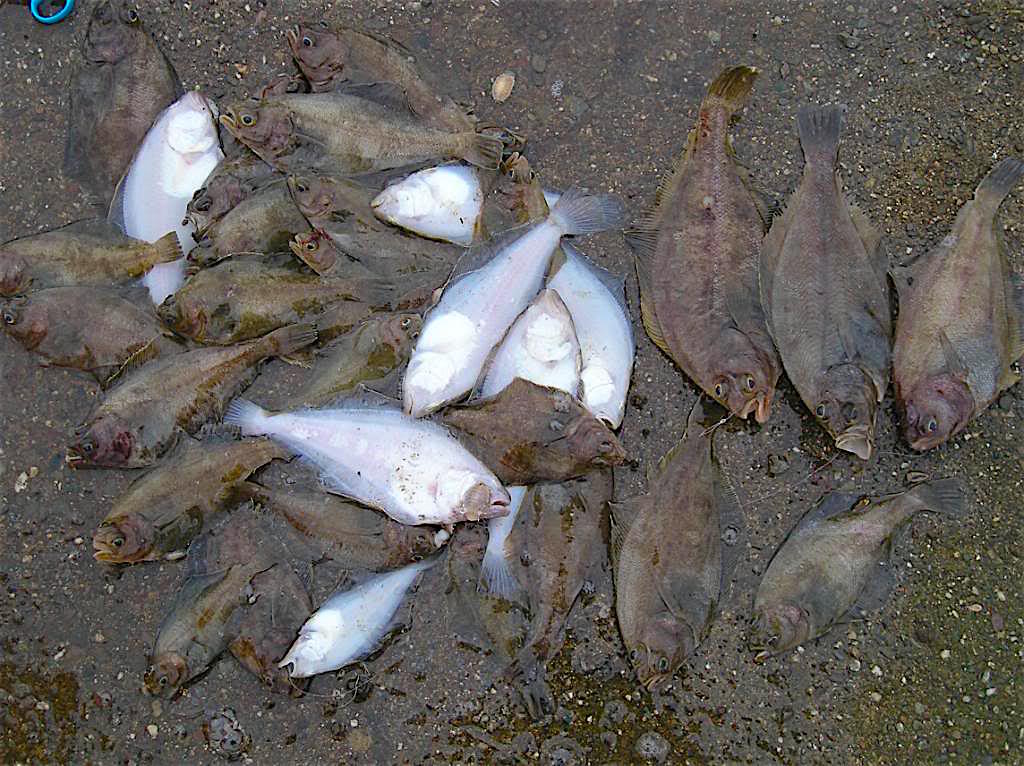
Sanddab hit best in wet winter months
For jacksmelt, use a fairly heavy rigging, attach three size 8 hooks to your line (spaced about eight inches apart), use enough weight to cast away from the pier, and finish with a large bobber, balloon or float (most anglers use Styrofoam) that will keep your rig near the top of the water where the jacksmelt like to hang out. When fishing is good, fishermen will pull in a jacksmelt on nearly every hook and some of the “horse” smelt will reach nearly fifteen inches in length. Although found in the area most of the year, wintertime can be especially good. That’s when Pacific herring (usually) move into the local waters to spawn. Large concentrations of jacksmelt will be close behind perhaps hoping to dine on a few of the herring eggs. It’s one of the best times to use artificial lures on the jacksmelt, with anglers primarily using small spinners and spoons.
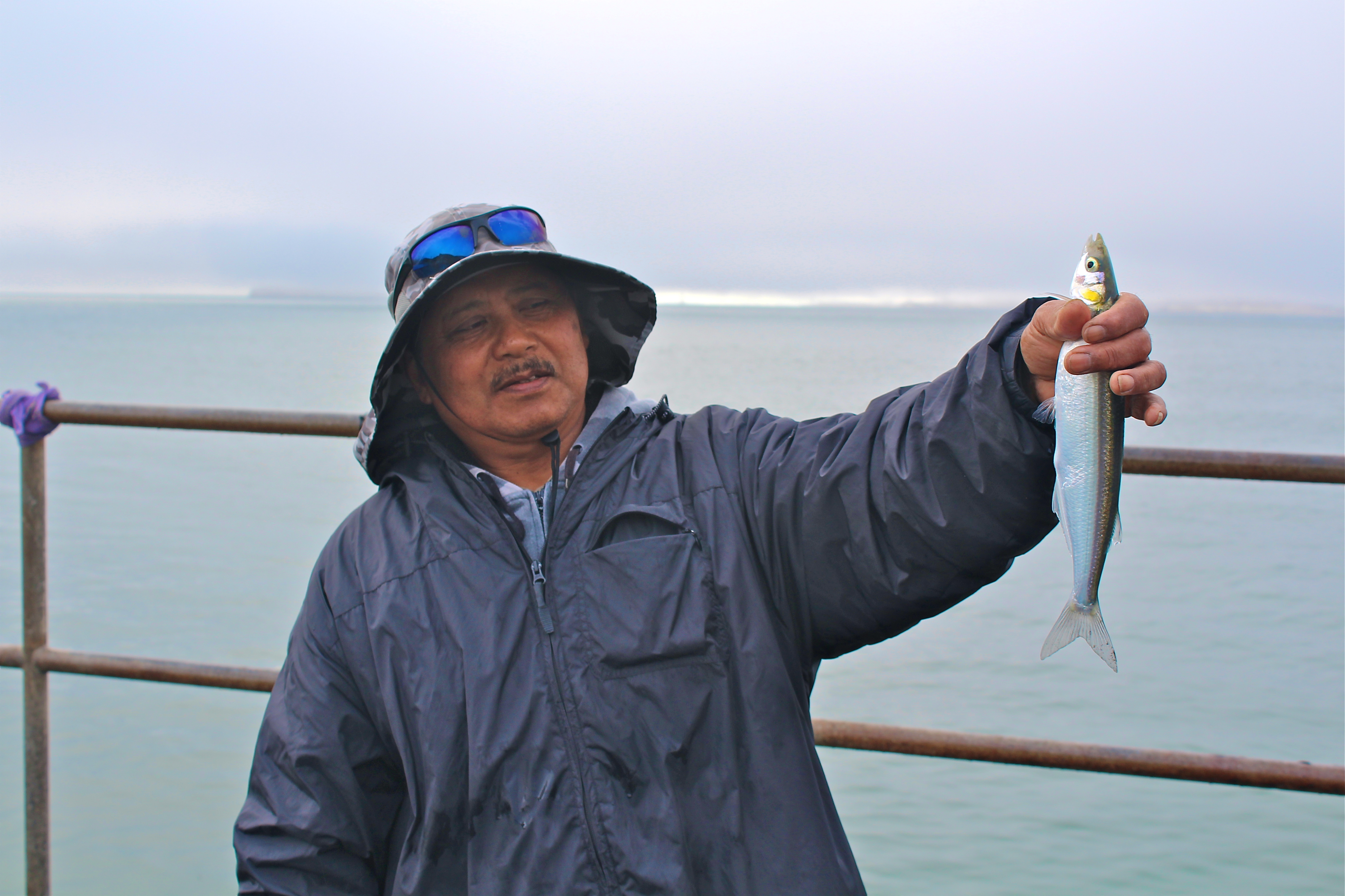
Jacksmelt
Although the pier is primarily a pier for jacksmelt, perch and crabs, big fish do show up. This is an area that sees some striped bass, salmon and sturgeon caught most years.
The pier would seem to be an ideal area to catch striped bass given the number taken by Sportfishing boats in the area. But, the pier has never reported large catches of Mr. Lineside nor really large bass (the largest I’ve seen reported being a 27-pound fish). Nevertheless, a few are caught each year, with most being caught by anglers using live bait such as anchovies, shinerperch or bullheads (staghorn sculpin). The best spot seems to off the far right corner of the pier or along the right side. Artificial lures can also be used if there are not too many other fishermen present. Check local tackle shops to see what has been working for anglers casting from shore.
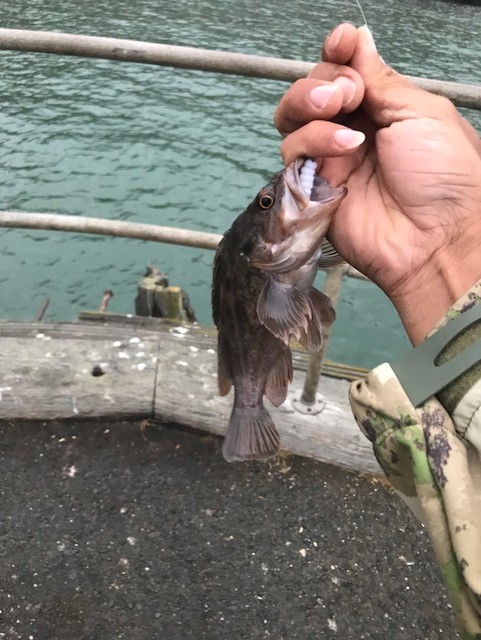
Brown rockfish caught on a white lure by Matt Shockley — makes it look like its got a good set of teeth
King salmon are sometimes caught during the summer, especially when schools of anchovies are clogging the water around the pier. When present, the best bait is a whole anchovy fished a few feet under a float.
Sturgeon are often present winter to spring months, especially when the herring are spawning in nearby areas. Sometimes they’re present in large numbers. One day in the mid-‘70s I saw nine keeper-size sturgeon laying in a row near Point Cavallo (just past the jetty/breakwater to the left of the pier), none was under thirty pounds, and all had been caught by a group of anglers fishing from the ROCKS at the point. Several mentioned how hard it was to fight the fish from the rocks and then climb down, gaff, and pull the large fish up to the top of the cliff. Needless to say, they felt it was the greatest day of fishing most had ever experienced.
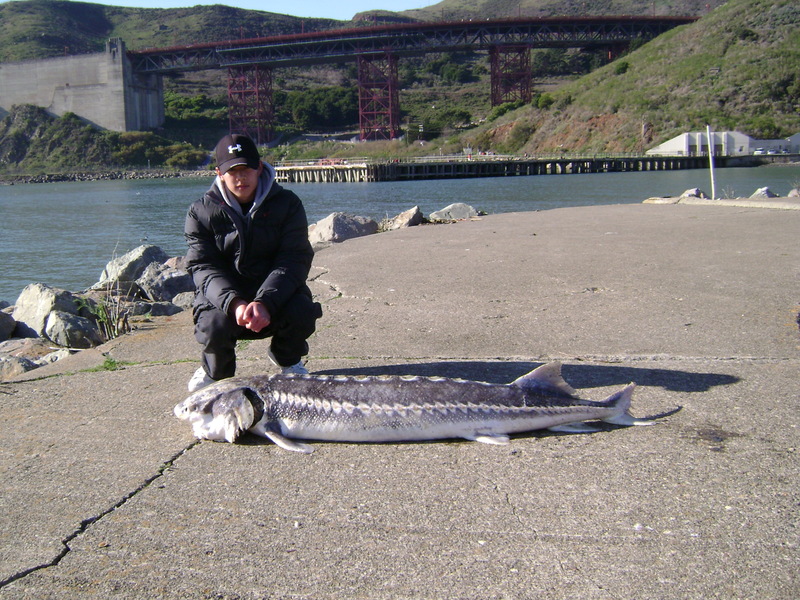
White sturgeon from the jetty
Today this area is closed for sturgeon fishing from January 1 to March 15; the fish were simply too numerous and too easy to catch. In addition, there was a problem at one time with anglers snagging the fish. However there are still fish present after March 15, so it is an area an angler might want to try. If you do try for sturgeon remember to use heavy tackle and remember to have appropriate equipment to land the fish. Although ghost shrimp, mud shrimp, and grass shrimp were the traditional year round baits (perhaps along with eel), the sturgeon gorge on herring eggs and herring during the restricted winter months. Some anglers go out at low tide during these times and collect the eggs (you are allowed 25 pounds a day) from exposed rocks and pilings and then save them for bait. Other anglers use the herring themselves. Whatever works!
The most common large fish will be the sharays—sharks and rays. Brown smoothhound sharks, leopard sharks, soupfin sharks, and bat rays are always a possibility when fishing on the bottom; sevengill sharks and big skates are caught just often enough to keep it interesting.
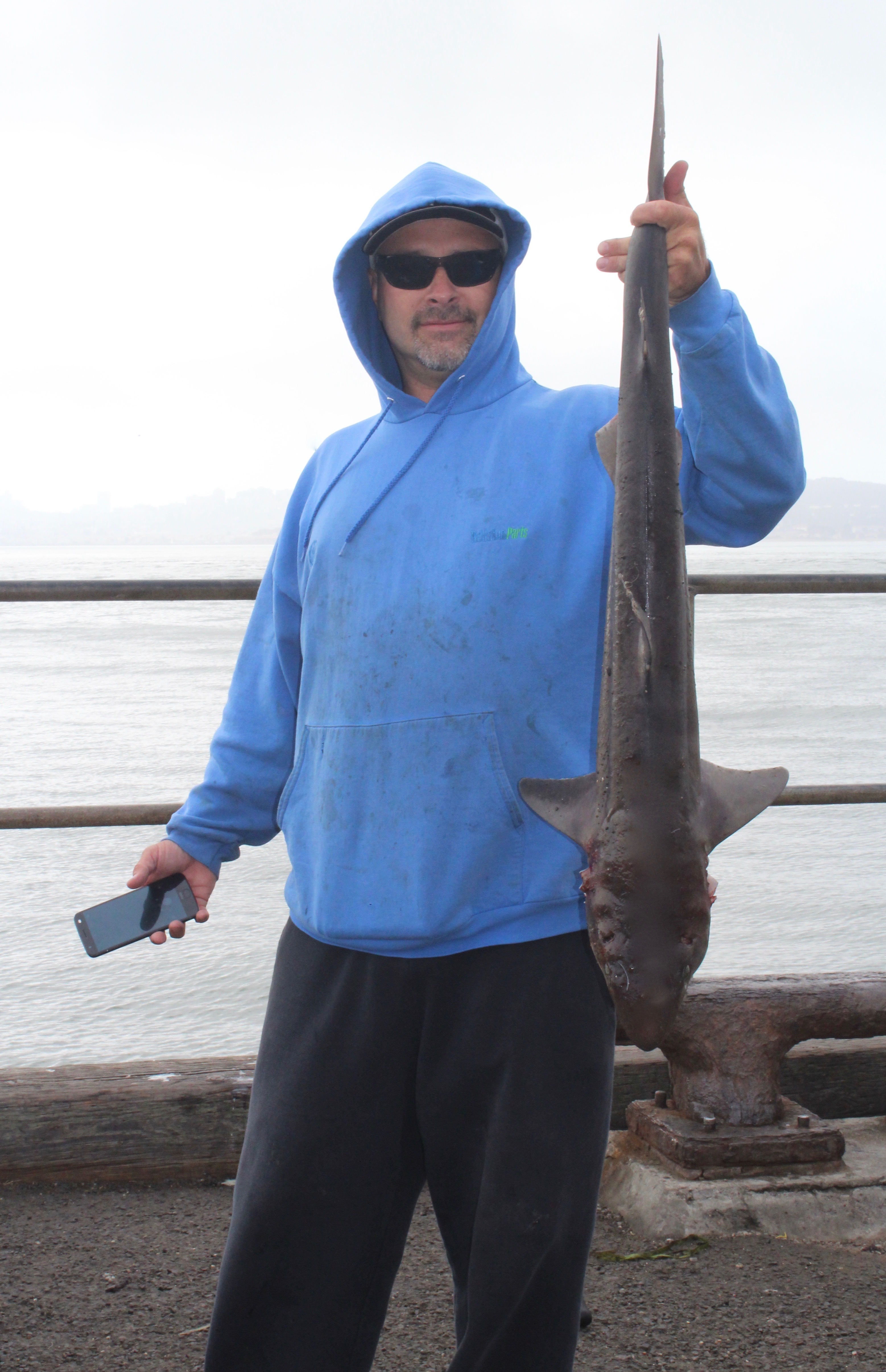
Soupfin shark caught by Jimmy Athas
Most years will see some leopards exceeding 30 pounds in size and a few bat rays approaching or even exceeding 75-100 pounds. Most of the sharks and rays I’ve seen here were caught by people who had cast straight out from the end of the pier, or cast from the side facing the Gate (although many leopards also seem to be caught in the somewhat shallow water on the south side of the pier). For all of these, squid makes good bait and the evening hours are the prime time. Remember to have a strong rod and reel, a stout line, and a net for these large creatures. It also pays to have a friend to help with the netting.
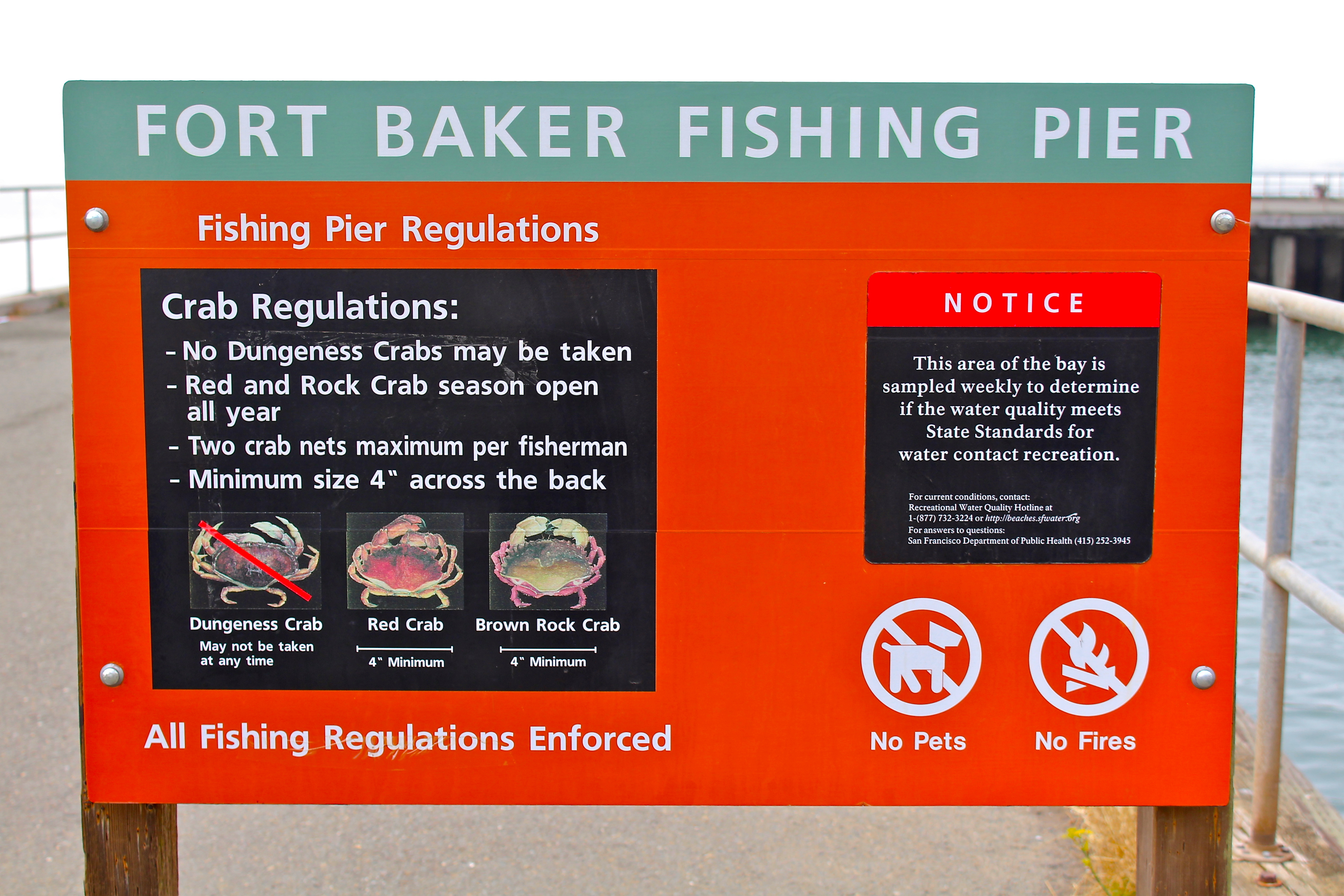
Red and Rock crabs are OK, not so with Dungeness crabs
Last but not least is the excellent crabbing that can be had at the pier. In fact, often times there are more people crabbing than fishing. Just remember that you are inside the bay and can only keep the red crabs and rock crabs, you’re not allowed to keep the Dungeness crabs that may also show up in your nets. Although really rare, we’ve also received reports of another crustacean occasionally showing up in the Fort Baker crab pots—spiny lobsters. The lobsters were a long distance from their usual southern California homes but more than one has been reported.
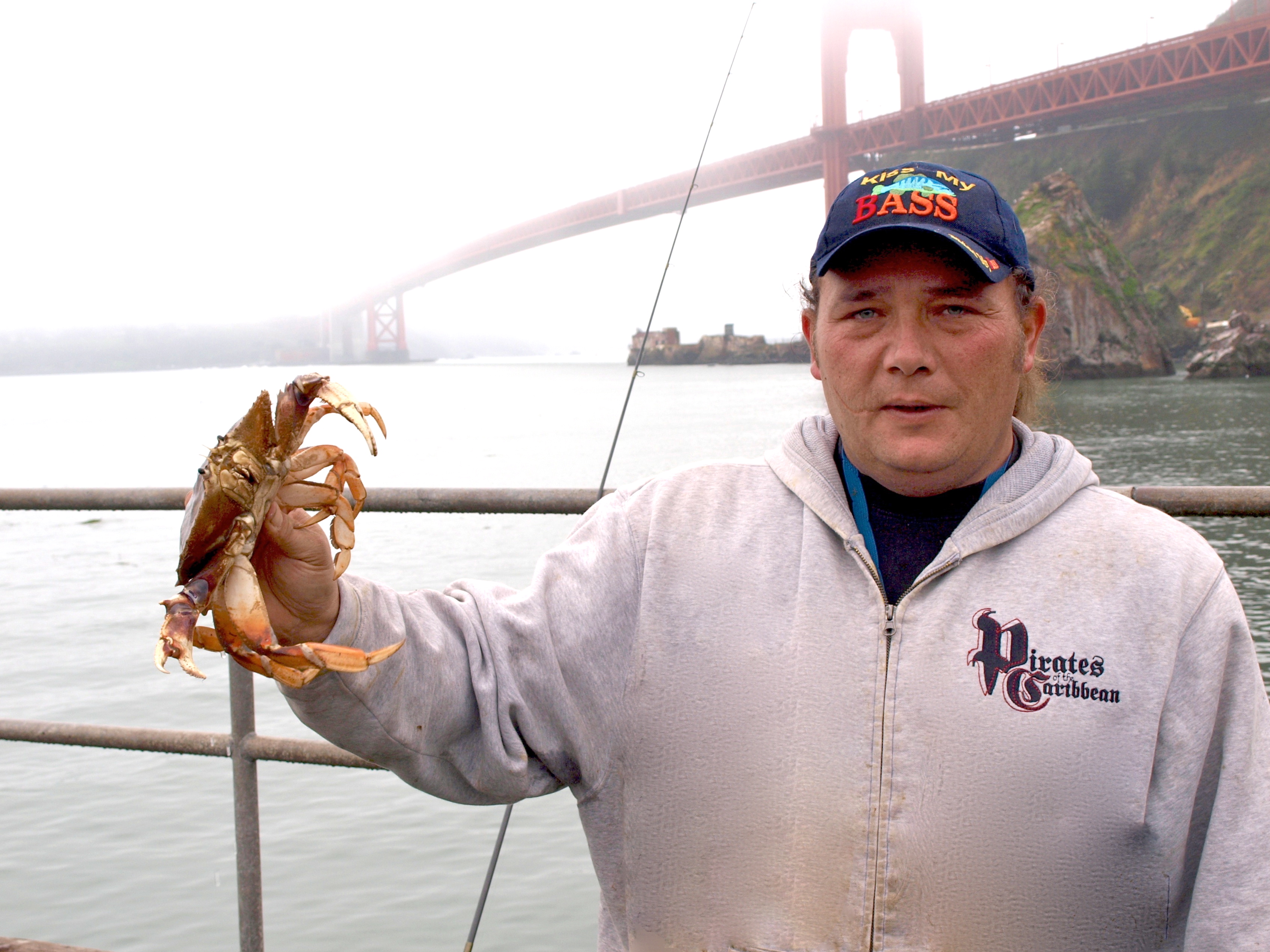
Illcatchanything (Brian Linebarger) and a crab but it’s a Dungeness and must be returned to the water.
The Pier Rats Speak
Date: August 22, 1998; To: Ken Jones; From: Dwight H; Subject: Pier Fishing
Hey Ken, I just got back from fishing Fort Baker! I caught one rather large rubberlip perch and a skate…but what really irks me is that I had three HUGE unknown fish fight with me for a while and subsequently snap my line! The first one was like a large wave of fish that just took my bait and snapped my line! The second one, I fought for a good while…running up and down the pier in order to keep up with it…and then IT happened! The third one was ferocious! I don’t think I’ve ever had anything on that big before! But after a few seconds of fish wrestling, that one too got away! Ugh…I”M SO PI..!!! It’s time for Dwight to head to the sports shop and buy super thick fishing line and head back out there! I was using anchovies. Any idea what it could’ve been?
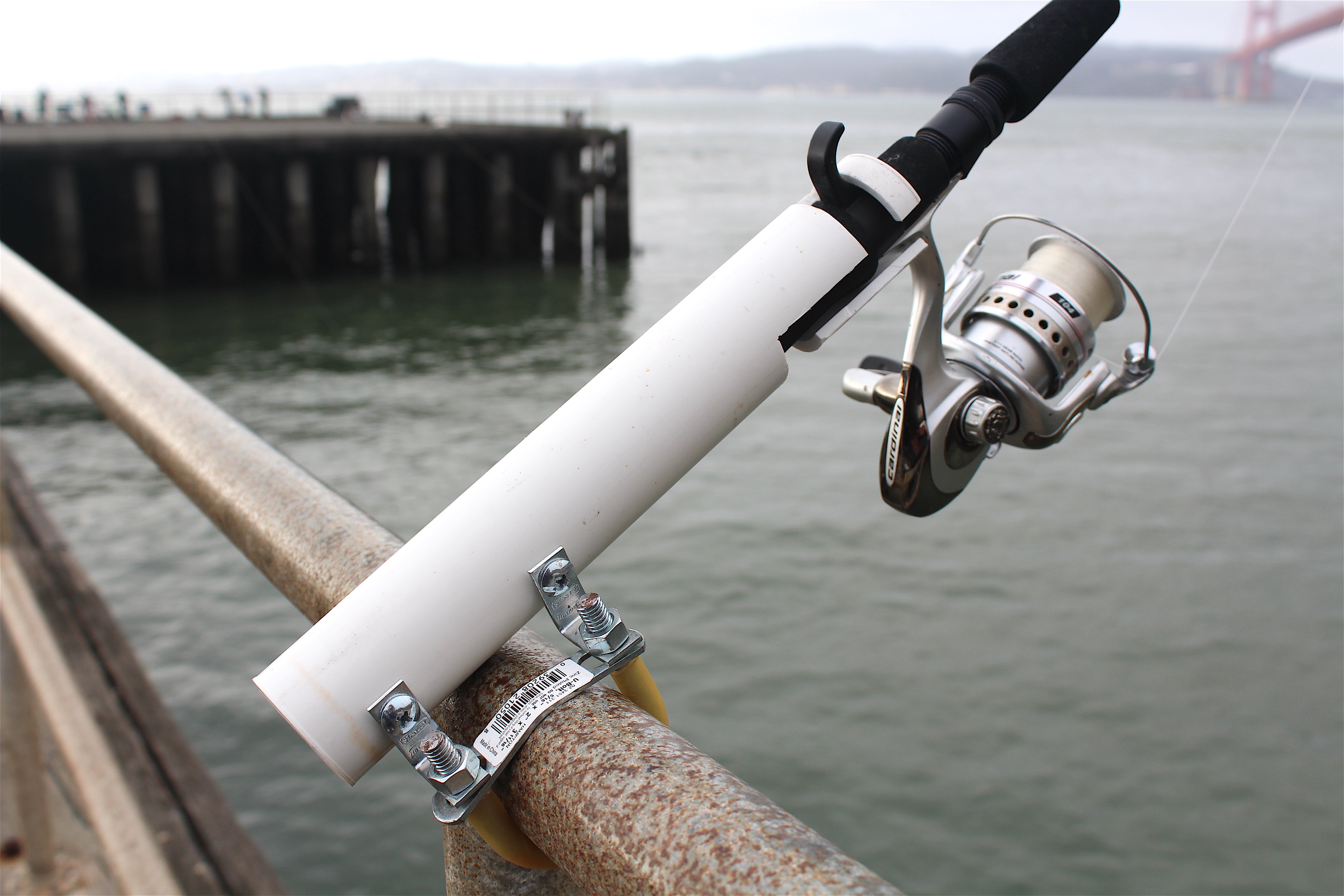
A rod holder designed for the pier
Date: December 18, 2004; To: PFIC Message Board; From: Mr. Pole Pack; Subject: Fort Baker, Saturday – Yabba-DABa-doo!
Hit FB with my son and some squid to catch some hyped sanddabs and crabs with squid. I met fakefisherman, his friend and another guy (didn’t get his screen name). The day was clear and crisp and there were about 20 anglers out at noon. After losing a leopard shark, I caught a 10″ sanddab, My first! Fun little fish kinda reminded me of bullhead hits. Steady action for about two hours with everyone catching.
Weird thing… after filling my bait cage with squid, I pulled it up and all the squid was gone except the bait cage was still tightly closed? What could have taken 1/4 lb of squid without opening the cage? Octopus?
Met another guy with a Hummingbird shore fish finder. It was pretty cool but he told me it works best in lakes. Met the mysterious “homeland security agent.” They’re filming a time-lapse sequence of the bridge for a documentary.
Fakefisherman and friend caught a few dabs and crabs. We all left at sunset. Thanks for the extra fish, FF! Digesting the tasty morsels as I type this.
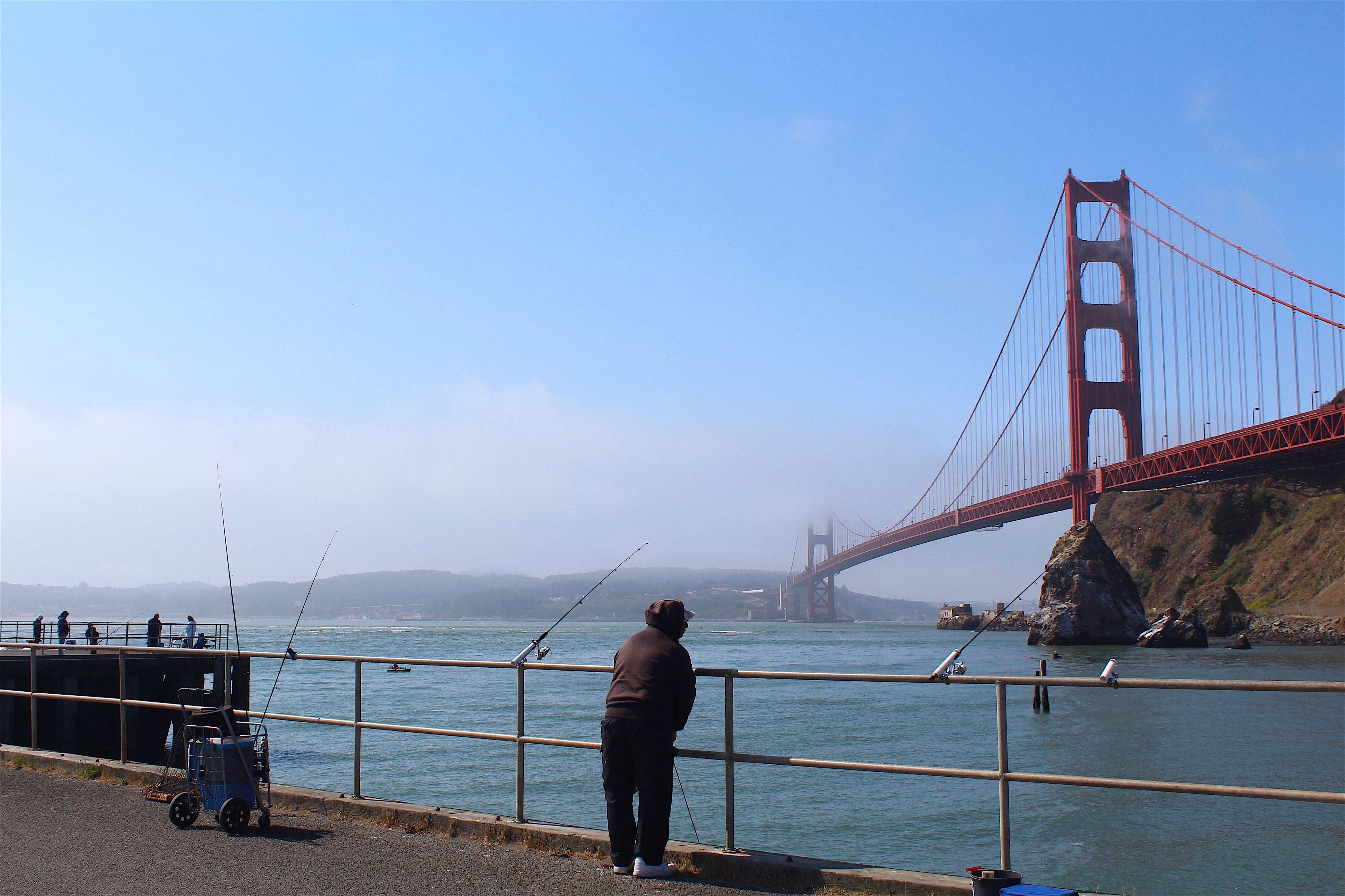
A perch angler
Date: November 29, 2009; To: PFIC Message Board; From: Juanito; Subject: Fort Baker Pier
Hey fellas! So I went fishing to Fort Baker Pier today, as some of you suggested for smelt. This is my first time to this pier as I recently moved in the Bay Area. First of all, I must say that FB is a beautiful place to fish. U bay area folks really have it made. Anyhow, I started fishing around 8am. I set up one rod with a high low baited with pile worms that I cast out and jigged back in to cover more area, and set up another rod with pretty much a high low but with three hooks (two with pile worms, and one with a piece of shrimp) that was stationary. Less than 5 minutes on the water and I get a bite on the rod that I was jigging in and it ended up being an 9” pogie. Soon afterwards my bobber starts going up and down. I set the hook and get a really good fight, and find that I hooked two jacksmelt simultaneously. Later, I get kinda bored of bait fishing so I fish a pumpkinseed grub on a Carolina rig for perch, and I caught 6 perch. The biggest being 12”. I can keep going on and on, but the action was hot all day. I decided to call it a day at 12pm. To sum it up, I caught countless jacksmelt and I caught a good amount of perch (mainly pogies and few rubberlip) out there as well. I released all fish except the first pogie that swallowed the hook, and couple jacksmelt that wouldn’t make it. I don’t really enjoy eating jacksmelt (or perch for that matter), but it’s better than freshwater trout any day.
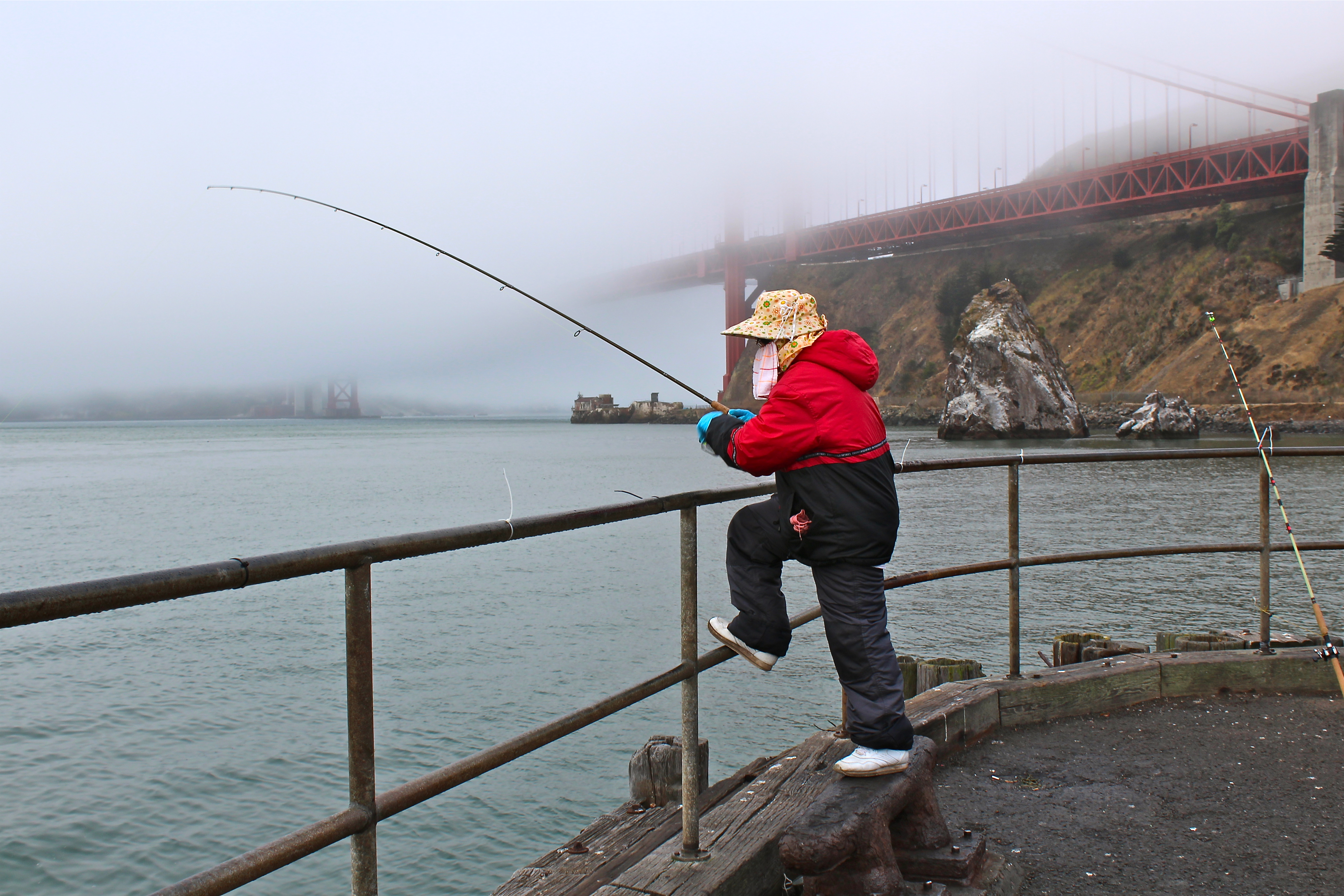
Some days (actually many days) can be cold and foggy
Date: December 10, 2009; To: PFIC Message Board; From: dsrtgl; Subject: Baby it was COLD out there!
OK… So maybe wire bait cages are NOT the cure after all. I had the pier pretty much to myself all day so I had the UNDIVIDED attention of all the resident furbags… I am REALLY beginning to hate the damn sea lions… I Crabbed with two rings today. The one with the larger bait cage got MUNCHED twice…losing all the bait and got dragged under the pier COUNTLESS times after I tried to continue crabbing with the ring after zip-tying the cage closed. Gave up on that ring and just crabbed with the one that was not getting bothered as much. Here a smaller (suet basket) size cage seems to get left alone.
Spoke to the F&G Warden and shared some intel (and photos) of local poaching activities. When he arrived there was actually another person crabbing and they were allowed to leave without a citation for not having a measuring device even though they were in possession of a crab… The crab was tossed back… Pretty nice of the warden if you ask me. The man’s cute as a button little girl might have had something to do with it though.
Fishing SUCKED!!! Crabbing was just ok… AGAIN I netted many crab that were missing one or both claws. People breaking the good parts off and the tossing the crab back….HATE THAT!… Twice saw octopus crawling out of my net on the retrieve. No sign of a herring spawn in the area but there were a lot of little jellyfish. Got pinched by a mean crab. Was bit on the butt by a pelican. Learned that SNEEZING when you have a stuffed up head and a running nose is NOT a good idea when you are wearing a ski mask… .ewwwwwwwwwwwwwwwwwwww! Pretty much have my crabbing spot dialed in. A few feet in either direction and you get nothing buy tiny Dungies. Only occasional brief sprinkles during the day. Very little trash to pick up on the pier. It was a SERIOUSLY low tide today it is shocking just how many crabbing ropes are wrapped around the pier pilings exposed by the low tide. Tried my home made grappling hook but a local named Tim looks like he has cleaned up most of the good stuff…. DID I MENTION IT WAS COLD!!!!!
Special Recommendation. As mentioned, this can be a cold and foggy area. Old records reported that the foghorn at nearby Point Bonito operated an average of 858 hours a year. So, bring some warm clothing just in case the fog does decide to settle in.
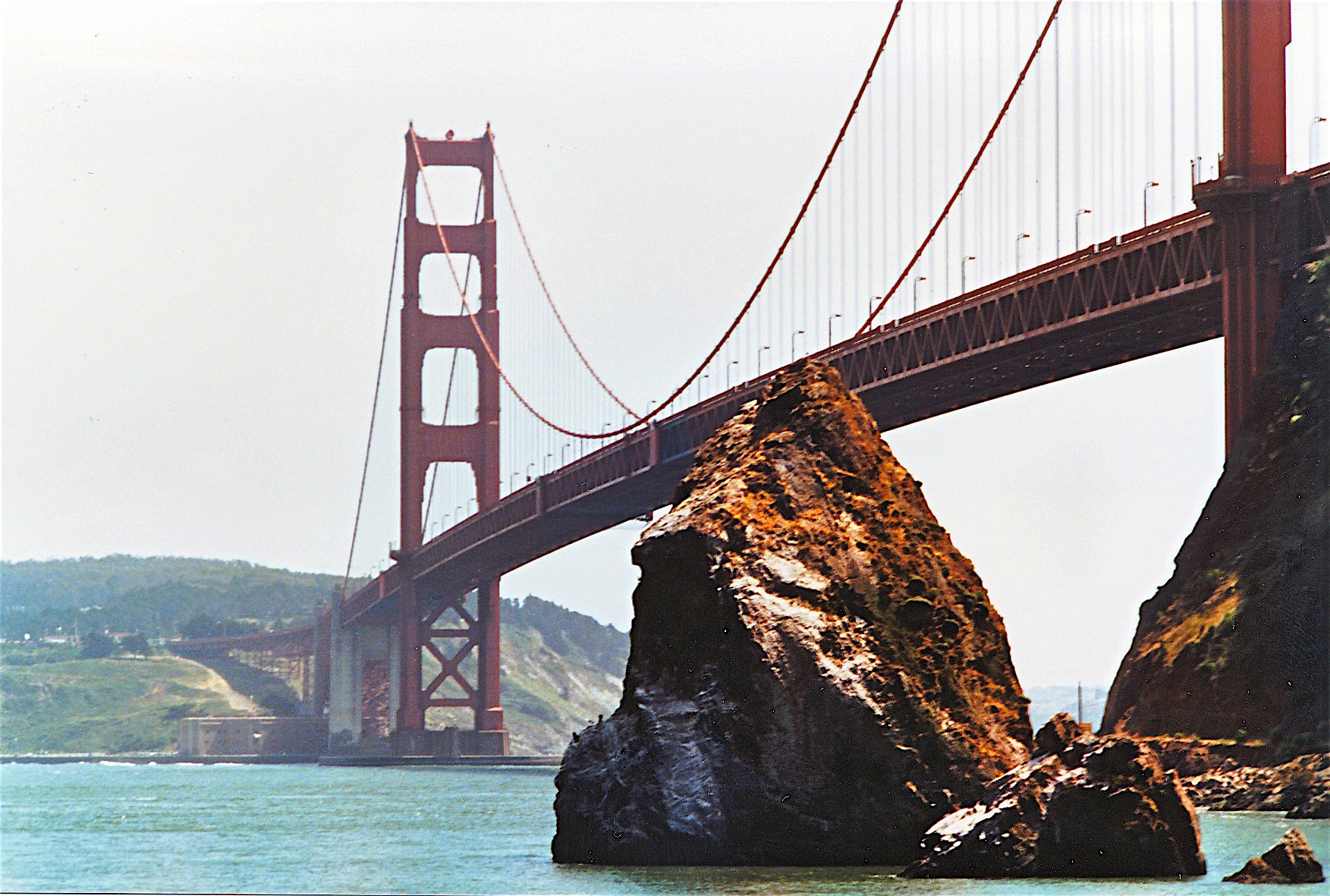
This rock sits out from the pier (picture taken in the ’70s)
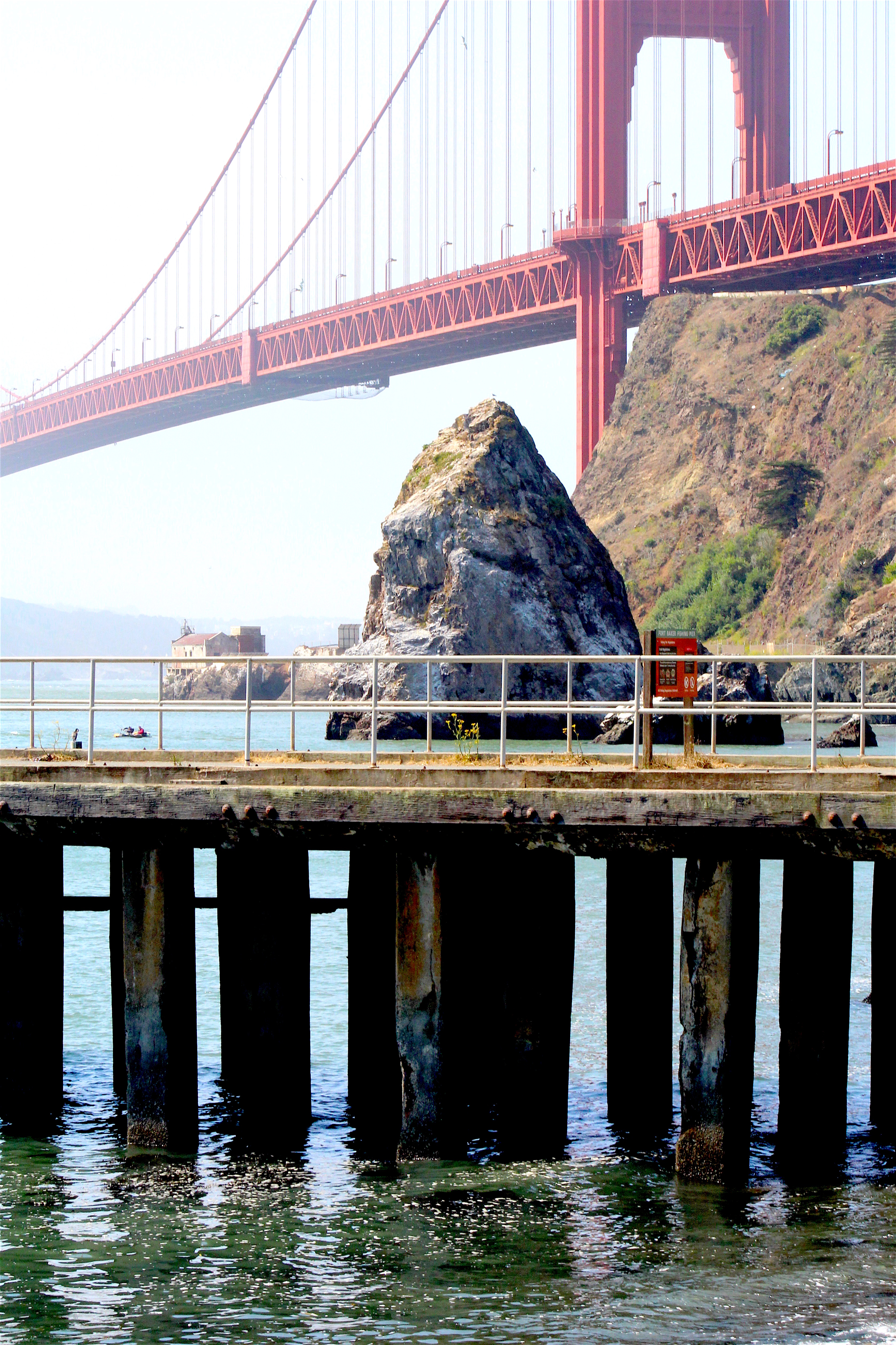
The rock, bridge, and pier are still there and hasn’t changed much in 40 years (picture taken in 2018)
Potpourri — Perhaps More Than You Want To Know About The Fort Baker Pier
<*}}}}}}}}}>< — Fish counts done by the California Department of Fish and Wildlife show that the two most common fish most years, numerically, are jacksmelt and Pacific sanddab with the remainder of fish primarily being perch and rockfish. As for the perch, ten species were counted numerically in the following order—walleye surfperch, striped seaperch, rainbow seaperch, white seaperch, shinerperch, black seaperch, pileperch, silver surfperch, rubberlip perch and redtail surfperch. The main rockfish were brown rockfish and grass rockfish.
<*}}}}}}}}}>< — Special Bay Area Regulations:
- A perch closure exits in San Francisco and San Pablo Bay from April 1 to July 31. No perch may be kept other than shinerperch (20).
- In San Francisco and San Pablo Bay a fishing line may not contain more than three hooks.
Sturgeon Regulations:
- A sturgeon report card and tags are required for anyone fishing for or taking sturgeon. (a) The card must be in the angler’s possession; (b) a tag must be used for any sturgeon retained by the angler; (c) the angler must record information on the Sturgeon Report Card immediately after catching and keeping or releasing the sturgeon.
- White sturgeon can only be kept from 40-60 inches; larger and smaller sturgeon must be released.
- Green sturgeon may not be taken or possessed.
<*}}}}}}}}}>< — Although fishing barges were a popular fixture in southern California Sportfishing fleets for over 60 years, they never seemed to catch on in central California or the Bay Area. Thus my surprise when I read about a fishing barge once anchored near Fort Baker.
Fishing Barge Open Off Southern Marin
Managers of the new fishing barge which opened in San Francisco bay last week-end are preparing for exceptionally large crowds of anglers over the Fourth of July week-end. Although business has been slow during the first week, owners E. A. Krug and R. S. Wibor anticipate a big week-end pick-up. The barge, a converted LOL is anchored off Yellow Bluff, by Fort Baker, and is open daily from 7 a.m. until 5:30 p.m. A water taxi, leaving Sausalito landing float every half hour, is provided and the transportation is included in the regular $3..50 per day fee for use of the barge. The location of the barge is described as the best spot in the bay for bass and cod fishing. — San Rafael Independent-Journal, July 1, 1949
<*}}}}}}}}}>< — You never know what to expect when you visit a Bay Area pier. In June of 2008 I stopped down at the pier for a short visit. Unbeknownst to me it was the day of festivities for the opening of the new lodge on the former army base—“Cavallo Point—The Lodge At The Golden Gate.” Driving down the road to the fort I noticed signs as well as tuxedoed chauffeurs announcing spots for pickups and I thought “uh oh.” Finally, at the bottom of the hill, I noticed an elaborate ceremony getting ready to take place. Obviously big bucks were involved given the elaborate set-up that blocked the path to the pier—a couple of hundred seats, a mobile stage, flowers and ferns aplenty, and numerous officials (although mandarins or apparatchiks somehow seems more fitting). It had the feeling of one of those typical Bay Area “we’re doing this for you” projects that somehow translate into upscale “kick the hoi polloi out of here” changes to the surroundings.

“Can I get to the pier?” was the question I asked the Park guard blocking the road with his vehicle. “Drive around the parking lot and don’t disturb the festivities.” “Uh, OK.” Soon I was fishing on the pier with absolutely no success.
Shortly thereafter, three saffron-robed monks showed up near the entrance of the pier where they proceeded to dump several pails of “something” into the water near the shoreline (while being filmed by a photographer. At first I thought it might be some sort of fish food but then I noticed much of it was white or gray and some was floating away (ashes?). Eventually, after they left, I wound up back by the front of the pier and did notice what looked like white lotus flowers floating amidst the green waters of the bay (but I still have no clue).
An hour or so later I was headed out of the park and thinking how things have changed over the years—and not necessarily for the better.
Still later, in checking out the “historic luxury” lodge’s website, I found out the rooms were cheap—if you have the “Do Ri Mi” and can afford a $569-$929 (+10% tax) room rates. As to activities—“today’s adventurers can explore nature, experience Northern California culture and renew themselves in stately hotel accommodations amid breathtaking views and stunning parklands… Within minutes, visitors can beachcomb along the Pacific, ride a San Francisco cable car or hike the Marin Headlands. No matter what the pursuit, Cavallo Point is the ideal ‘base camp’ for discovery and new experiences in Northern California.”
There is no mention of the proletarian pier fishing available near the front door of the expensive lodge.
<*}}}}}}}}}>< — Times and attitudes change, at least for some. There was a time when sharks and rays were seen as trash fish and when caught most were simply killed and thrown back into the water or tossed onto the pier. That attitude has changed for many but not all anglers. For both Pier Fishing In California (PFIC) and United Pier and Shore Anglers of California (UPSAC), one of the formerly reviled species that has become popular is bat rays. Although the fish are fairly good eating, we generally release them to fight another day. And, they do put up a terrific fight (battle) which has earned them the nickname “mud marlin.” For nearly a dozen years, until Berkeley Pier closed, an annual “Mud Marlin Derby” was held at the pier where upwards of a hundred people a year would try to catch — and release the affectionate beasts. Affectionate? Yes, if you’ve ever been to one of the petting pools at zoos and aquariums that have rays swimming around to be petted. What about the stingers which earned them the popular name sting rays? Turns out they can be clipped about once a month like fingernails and without those stingers they are not a danger. And then there are those Bette Davis eyes! The result is an attempt to protect the big fish and see they are not wasted.
One trip to Fort Baker had me testing the water. After arrival and fishing at an inshore area for a while I noticed something lying on the surface of the pier out toward the end. From a distance it looked like it might be a bat ray. I ambled out to the spot and sure enough it was a big bat ray, a dead bat ray, that was turned on its back for all to see.
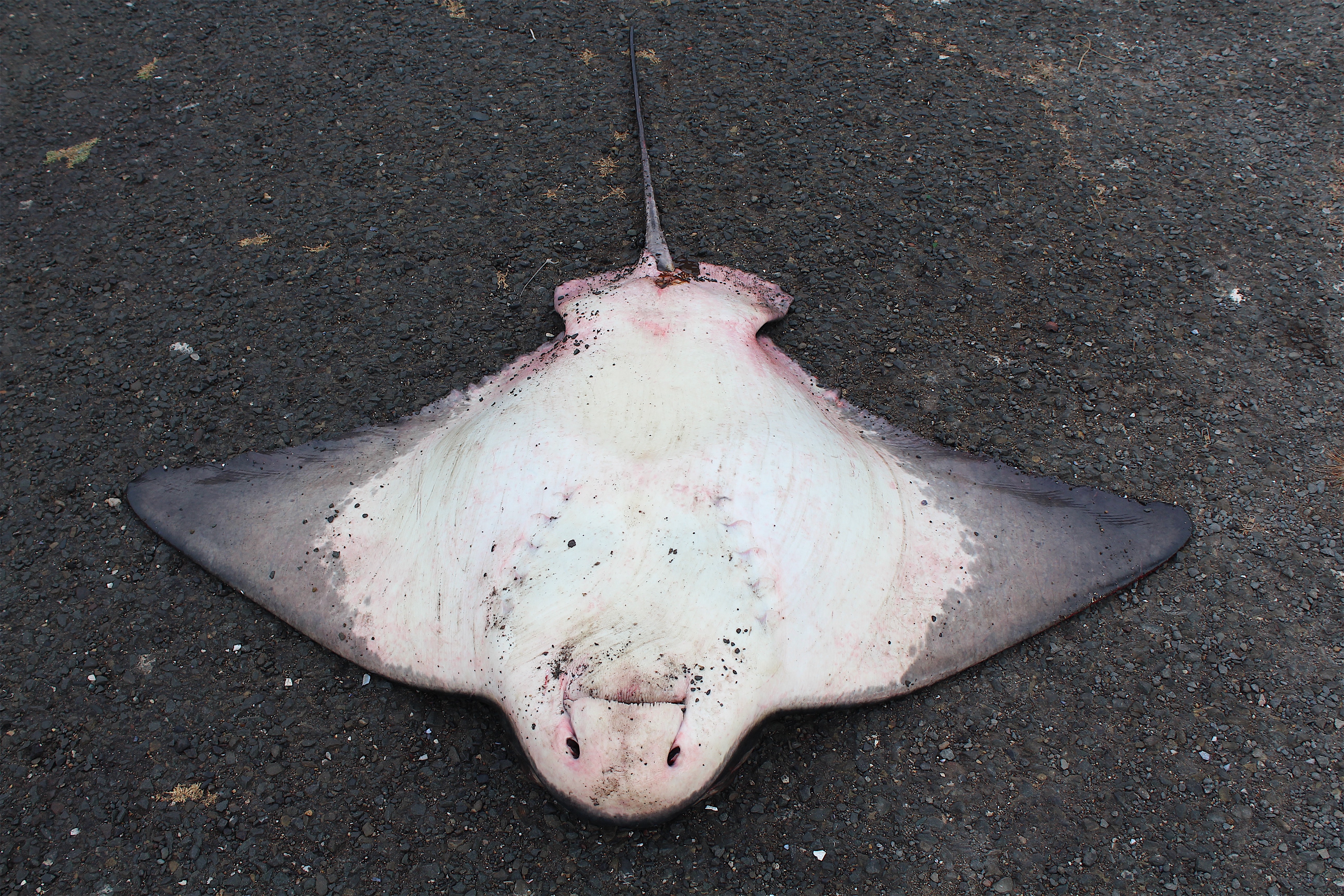
My immediate thought was is someone planning to eat the ray? If not, why had it been killed? Nearby was a group of anglers who seemed camped out at the end with their chairs, coolers, BBQ’s, and plethora of fishing equipment. I ambled over and asked one of the guys what they intended to do with the bat ray; were they going to eat it? No was the answer but then he said a nearby angler, a Chinese gentleman fishing for jacksmelt, had asked if he could have it. That gent told me he planned to eat it. He would slice off the tails and take them home and cook them. I mentioned that was good.
I don’t have a problem with anglers catching and eating fish but I do have an aversion to anglers that think they need to kill and display fish—and then do not use them. But, everything sounded O.K.
Later, I noticed the group caught two more large bat rays and they were dutifully lined up in a row with the original ray for the tourists to view. It seemed wrong to me and I wondered why the jacksmelt angler didn’t slice off the wings and put them in his cooler. However, eventually I did see him head over and start cutting off the wings. When I left he was also leaving and I hoped no additional rays were caught.
Personally, I prefer to return the rays to the water and I hope most people adopt that philosophy.
<*}}}}}}}}}>< — One of the things that has changed over the years, especially during the summer “tourist season,” is the number of people visiting the pier — most of whom are non-anglers. That fact was most noticeable during a weekend visit in August of 2018. When I arrived early in the day the normal number of anglers was on the pier and the limited parking spaces were almost gone. It seemed it would be a typical day. But what turned out to be only a fair fishing day, one that might seem dull, was never that due to the crowds of people.
Literally thousands of bicyclists (my estimate) came riding down the bike trail from the Golden Gate Bridge and most seemed to stop by the pier to take a selfie of themselves with the famous bridge in the background. Many headed out onto the pier. Although most were speaking foreign tongues, I did have nice talks with several including a couple of couples from Taiwan and Norway. I always enjoy playing mini-tour guide and pointing out the history of the area where I am fishing and this day was no exception.
The number of visitors was amazing and given that most were wearing shorts and T-shirts it was obvious that they were not expecting the cold fog and wind by the pier (which, of course, is typical San Francisco weather for August). Of course years ago you didn’t have tourists renting bikes on Fisherman’s Wharf, riding through the streets of San Francisco, riding by Chrissy Field, and then heading up, on, and over the Golden Gate Bridge. At the far end they head down the bike trail to Fort Baker and most seem to stop before heading on to downtown Sausalito and the ferries that will take them back to San Francisco. I prefer a car. But it certainly made the day interesting.
<*}}}}}}}}}>< — As mentioned, the views from the bridge are always interesting and sometimes they are stunning. I always have my camera and sometimes I seem to be paying as much attention to my camera as to my rod — a bad thing for a fisherman.
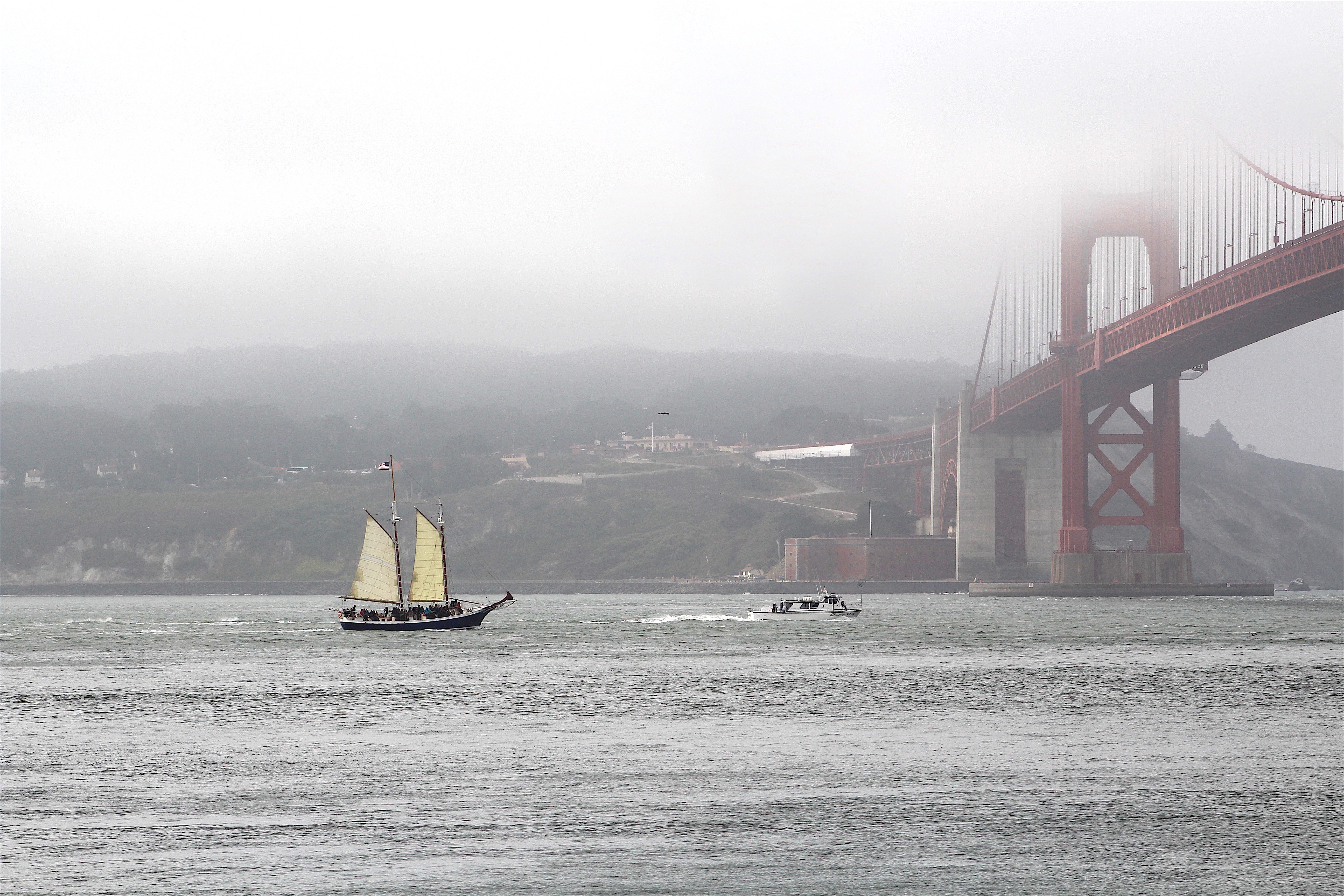
I thought this contrast between a modern Sportfishing boat and an old-style junk was interesting.
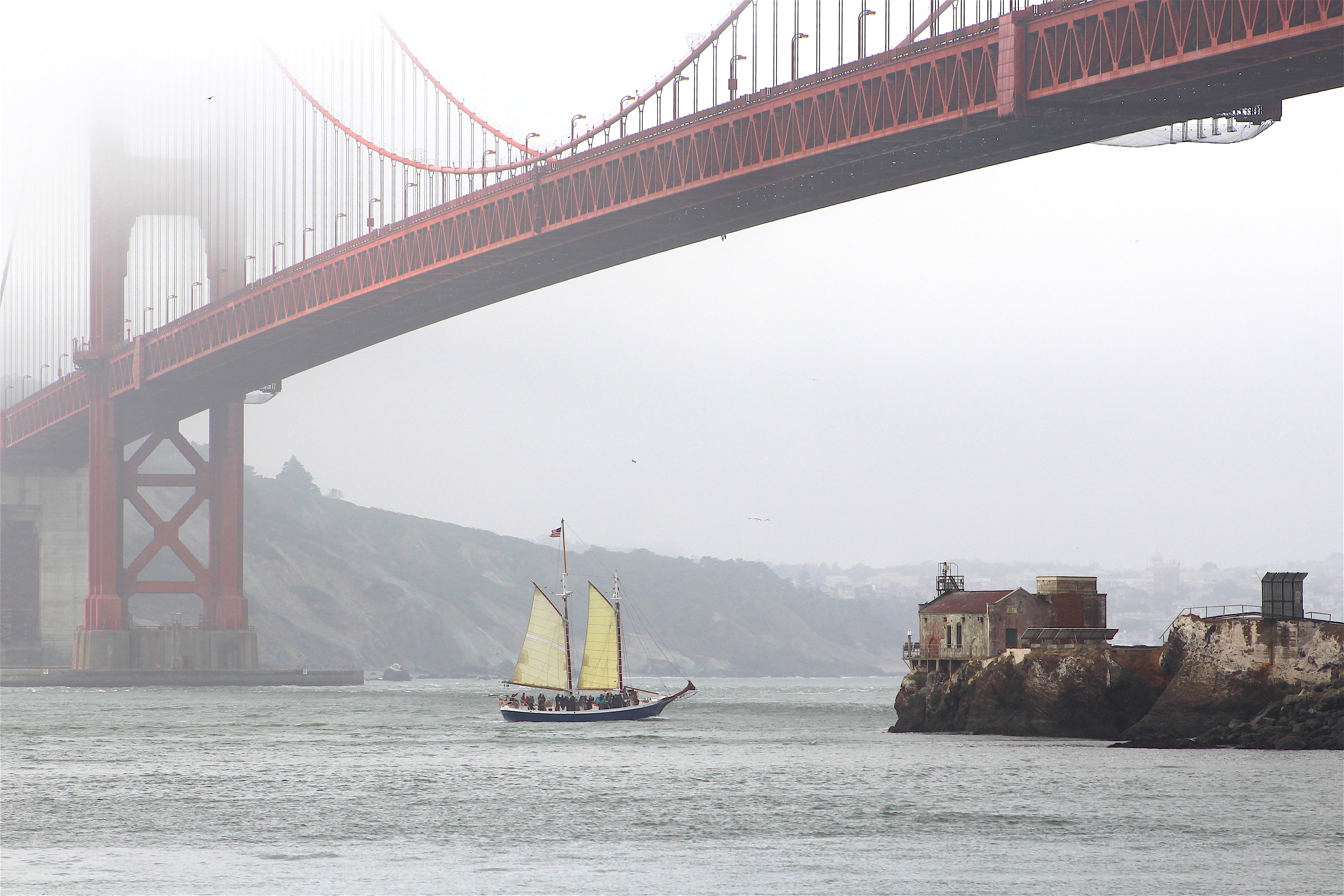
Even the junk itself by itself, and the bridge, were interesting.
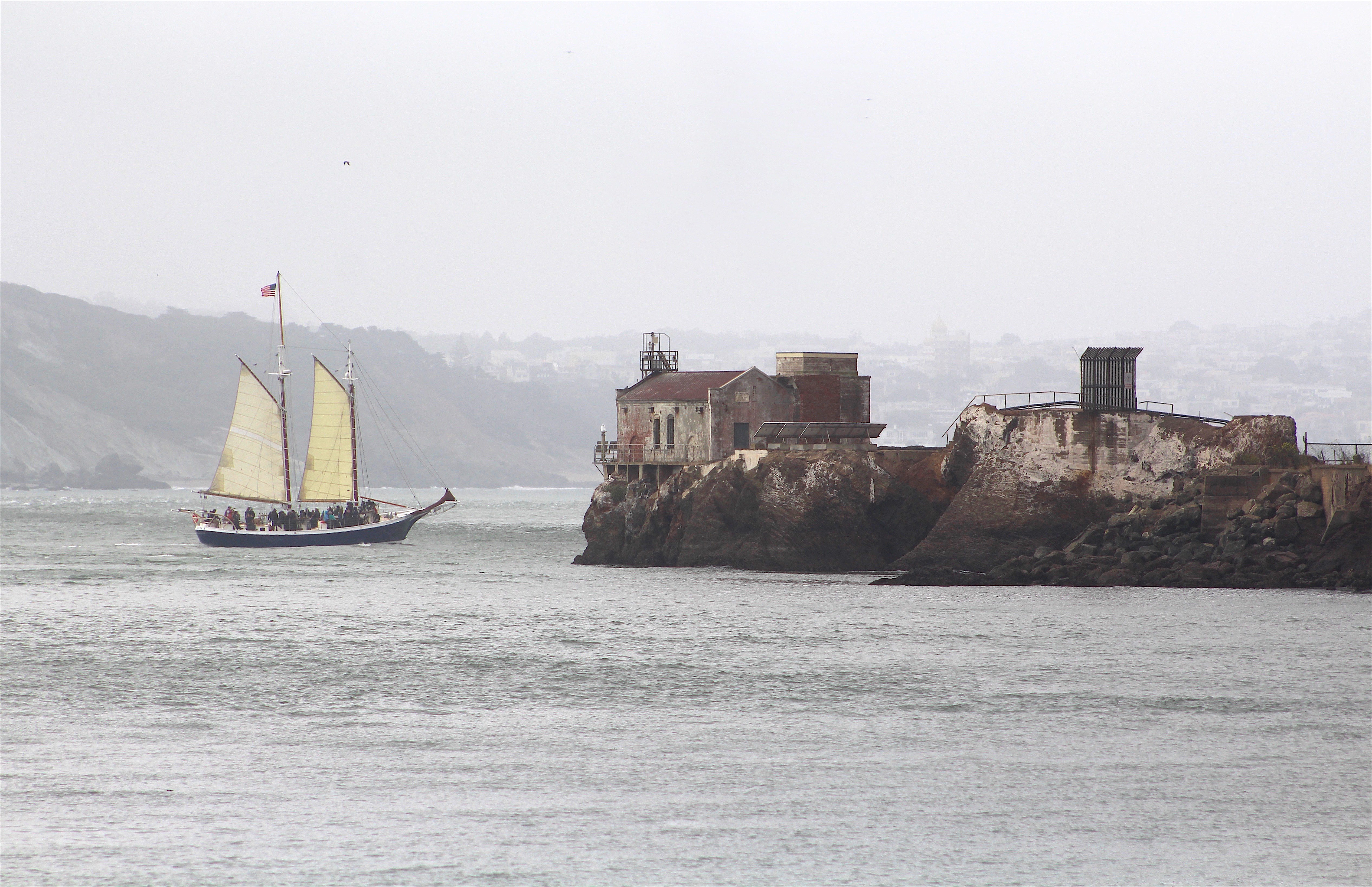
<*}}}}}}}}}>< —I’m not sure it’s the best pier but it’s one of the best.
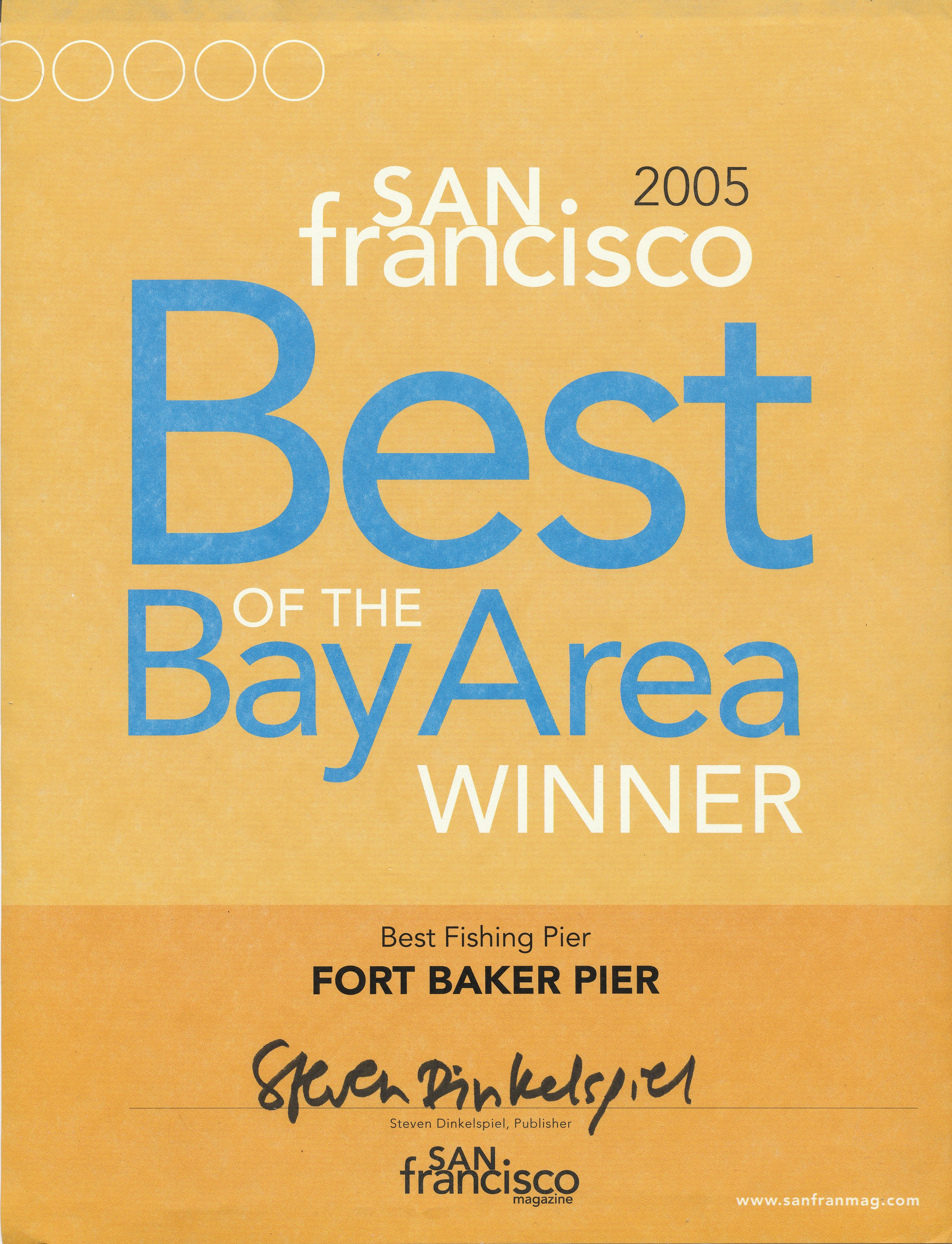
<*}}}}}}}}}>< — Given the usage the pier receives—anglers, tourists in cars looking for the perfect picture, and the thousands of tourists (many who are foreign visitors) who come barreling down the bike path from the Golden Gate Bridge, you would think the park would want to put a good foot forward and leave a good impression for these folk. But perhaps they simply forgot the port-a-potties that sit just a short distance from the pier? There is often a line of people waiting to use the portable outhouses and when they exit the same they are generally holding their noses and warning those in line to be prepared for the stench and filth. The last time I used one of the port-a-potties I noticed a sign that said: “dumping of hazardous material (in the potty) is a federal offense. In my mind the potty itself was a federal offense! It certainly is an embarrassment for the federal government that oversees the park and pier.
History Note. In the 1850s the Lime Point Military Reservation was established to protect the entrance to San Francisco Bay (and it is the oldest of the forts on the Marin Headlands). In 1897 it was renamed Fort Baker. Although diminished in importance after World War I, it would still later serve as the World War II Mine Command Headquarters and the Air Defense Command Headquarters.
The current pier was built in 1937 and saw repairs and modifications in 1940, 1948 and 1985. Today the pier is 358 feet long and 116 feet wide at its widest point.
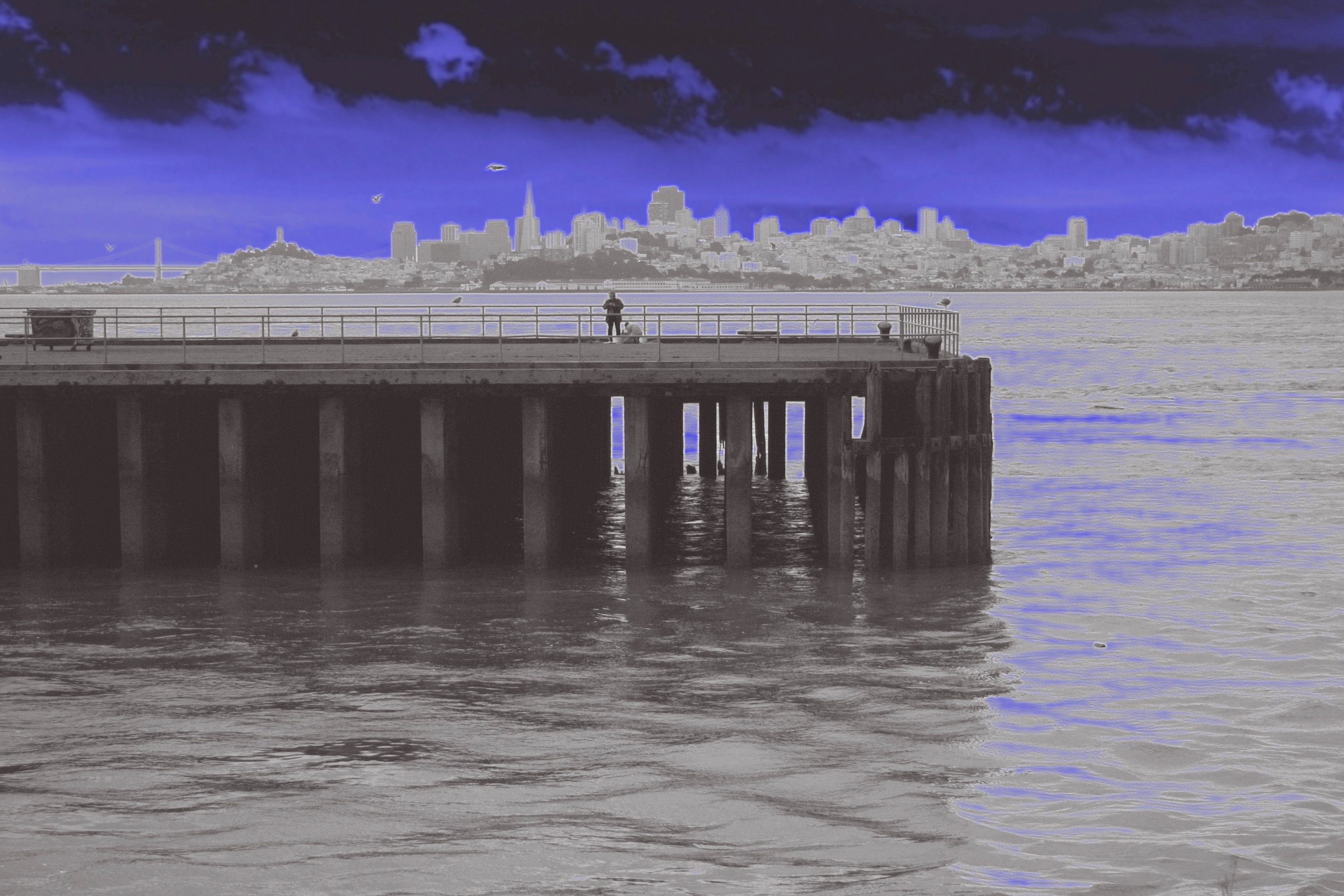
A Fort Baker “mood” picture by Red Fish (Robert Gardner)
Fort Baker Pier Facts
Hours: Gates entering the area are posted as opening at 7:00 A.M. and closing at 5:00 P.M. However, the gates are left open and many people fish on the pier at nights for sharks and rays. (Although there are periodic closures during terrorist alerts).
Facilities: Few! There is limited free parking at the foot of the pier (nine spaces) and some cars can park along the road itself. Probably no more than 20 cars can park altogether although there are additional parking spaces by the museum. There are no lights, benches, or fish cleaning facilities. Just up the street, less than a block away, is the Bay Area Discovery Museum, a good place to take the kids if they tire of the fishing.
Handicapped Facilities: Handicapped parking (one space), the surface of the pier is asphalt, and the railing is 52 inches high.
How to Get There: Take Alexander Avenue off of Highway 101. It is the last exit before driving onto the Golden Gate Bridge going south, and the first exit after the vista point going north. Take Alexander Drive exit and merge onto Sausalito Lateral Road, make first left onto Bunker Road, turn right and stay on Bunker Road (do not pass through the tunnel) down the hill. At the stop sign turn right onto Murray Circle till you see Moore Road. Take Moore Road to the pier.
Management: The Golden Gate Recreation Area.
